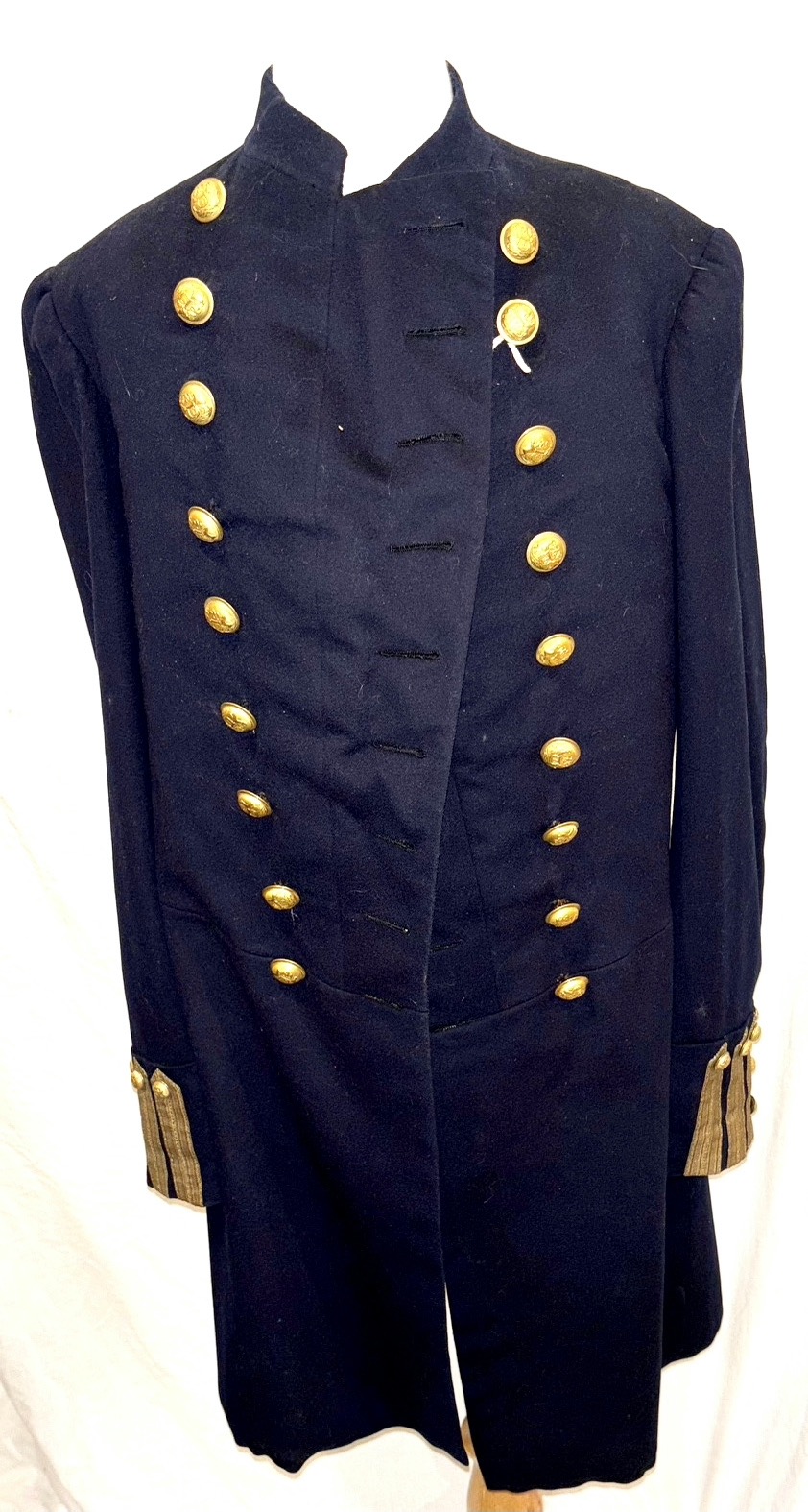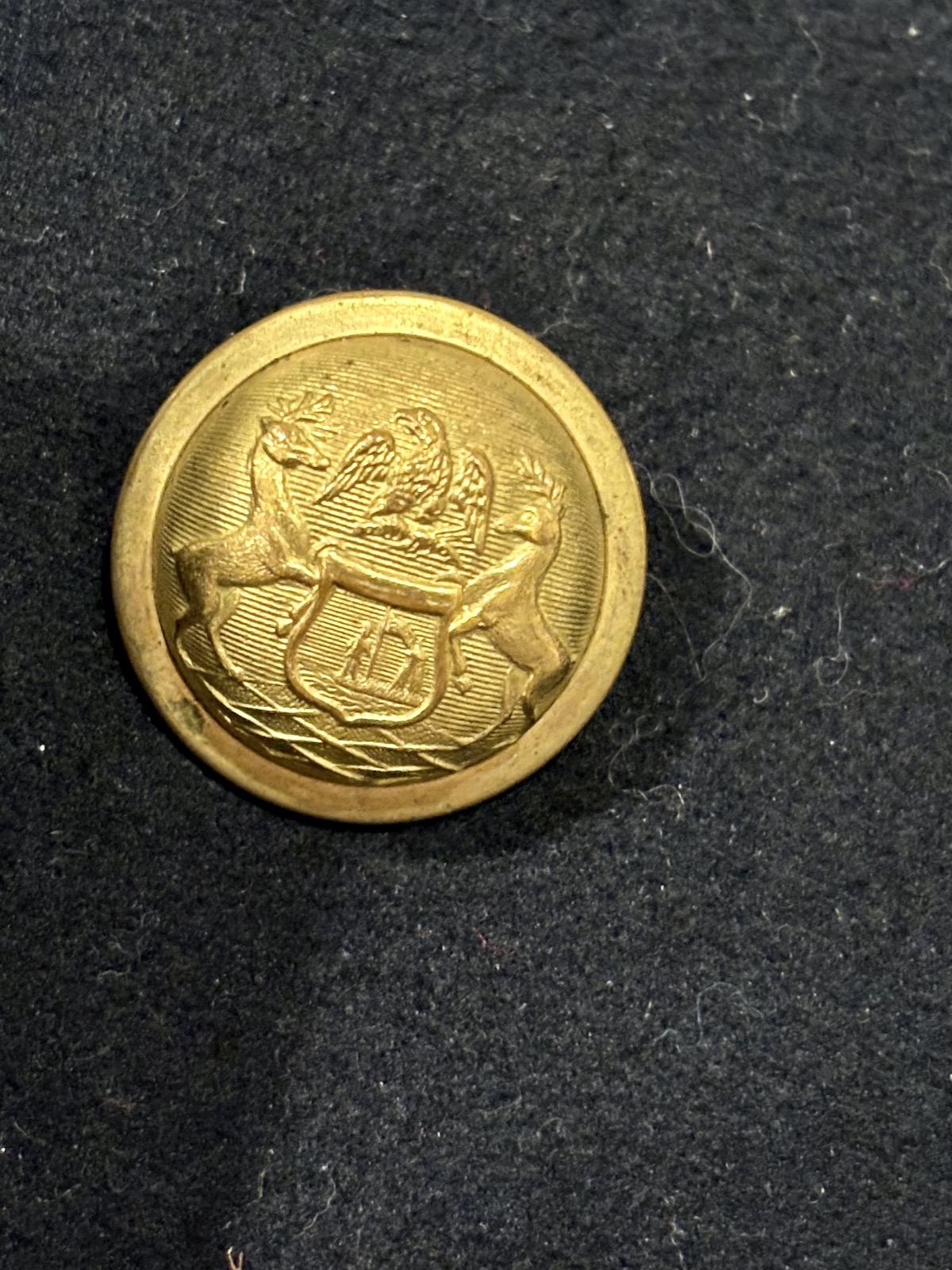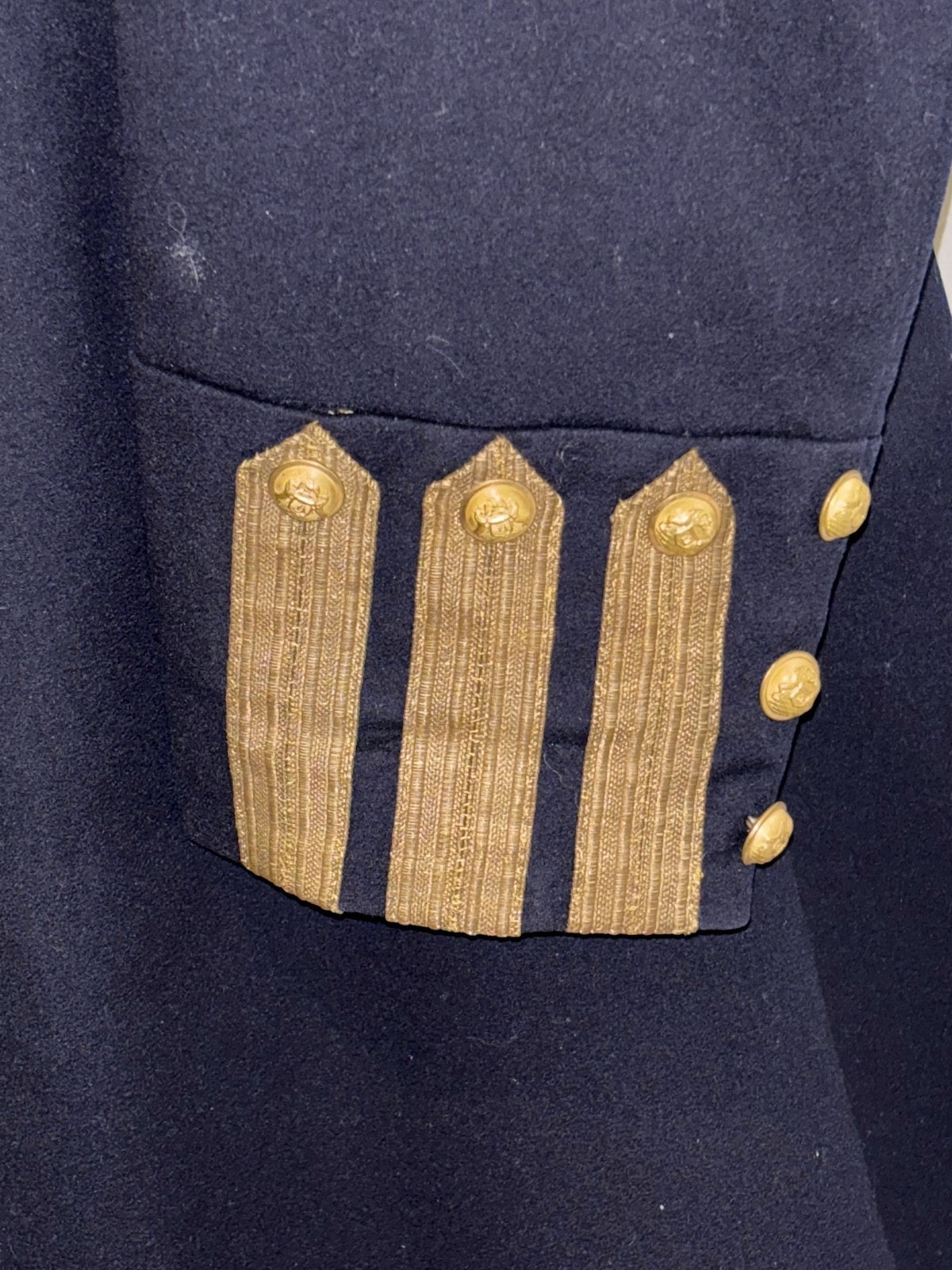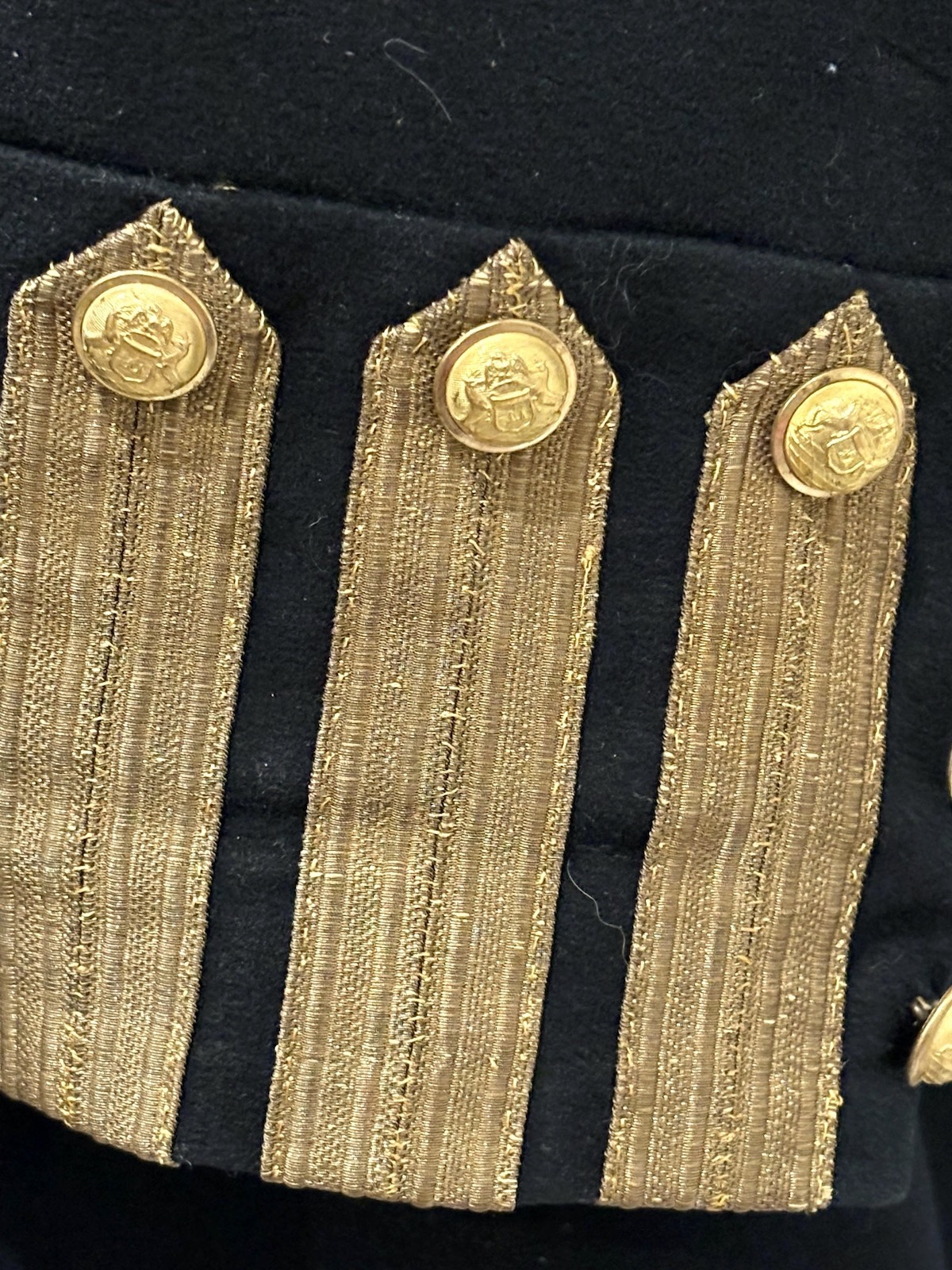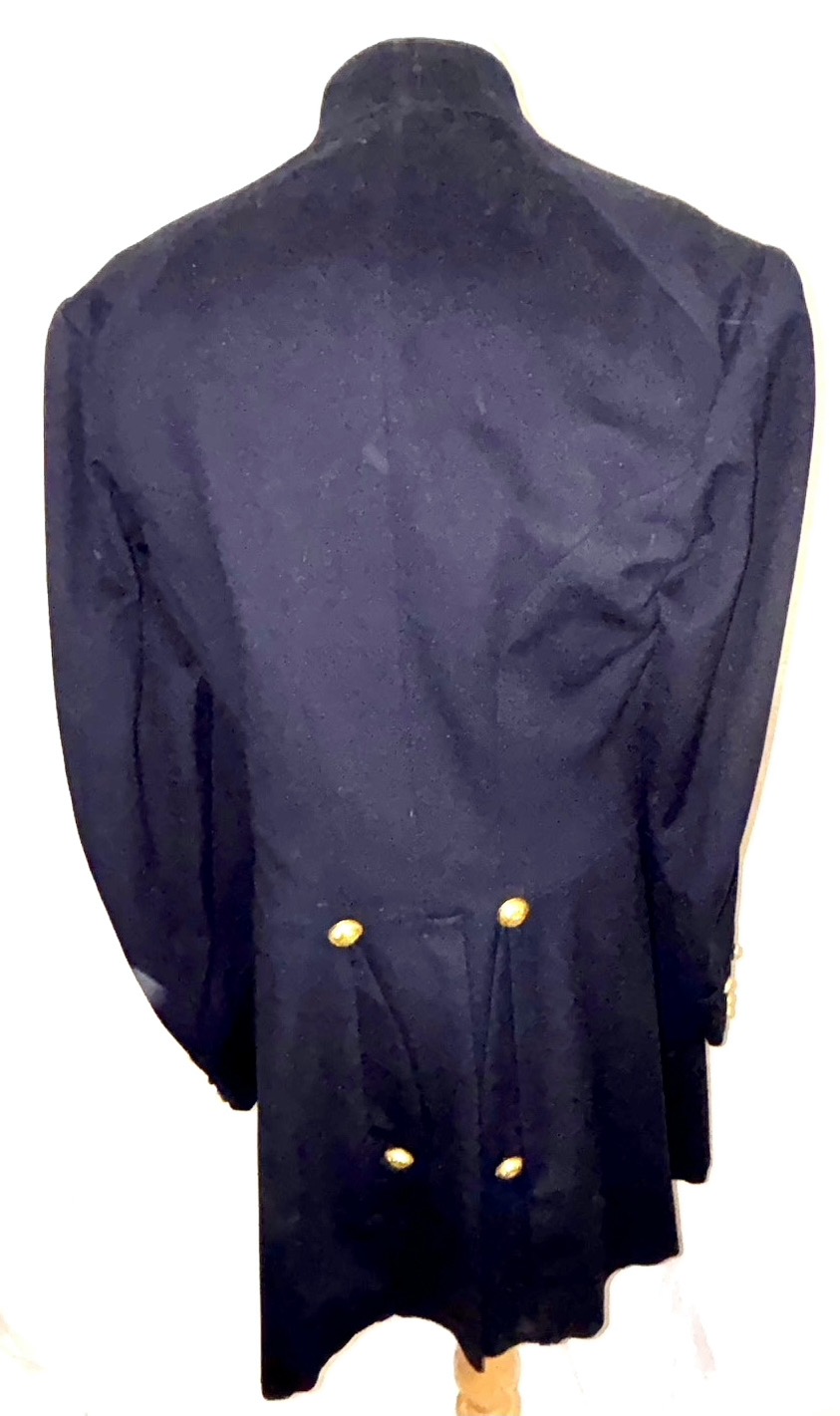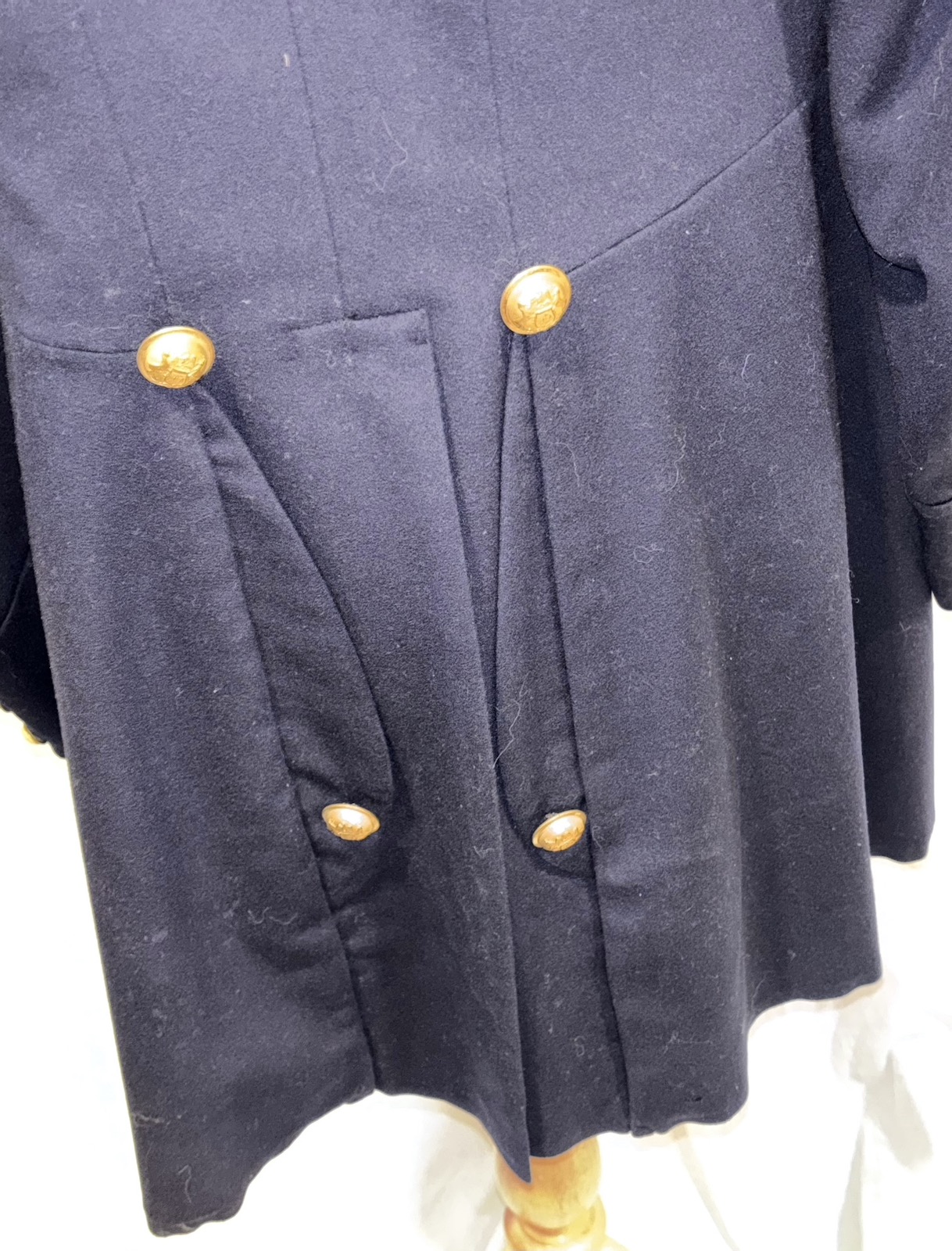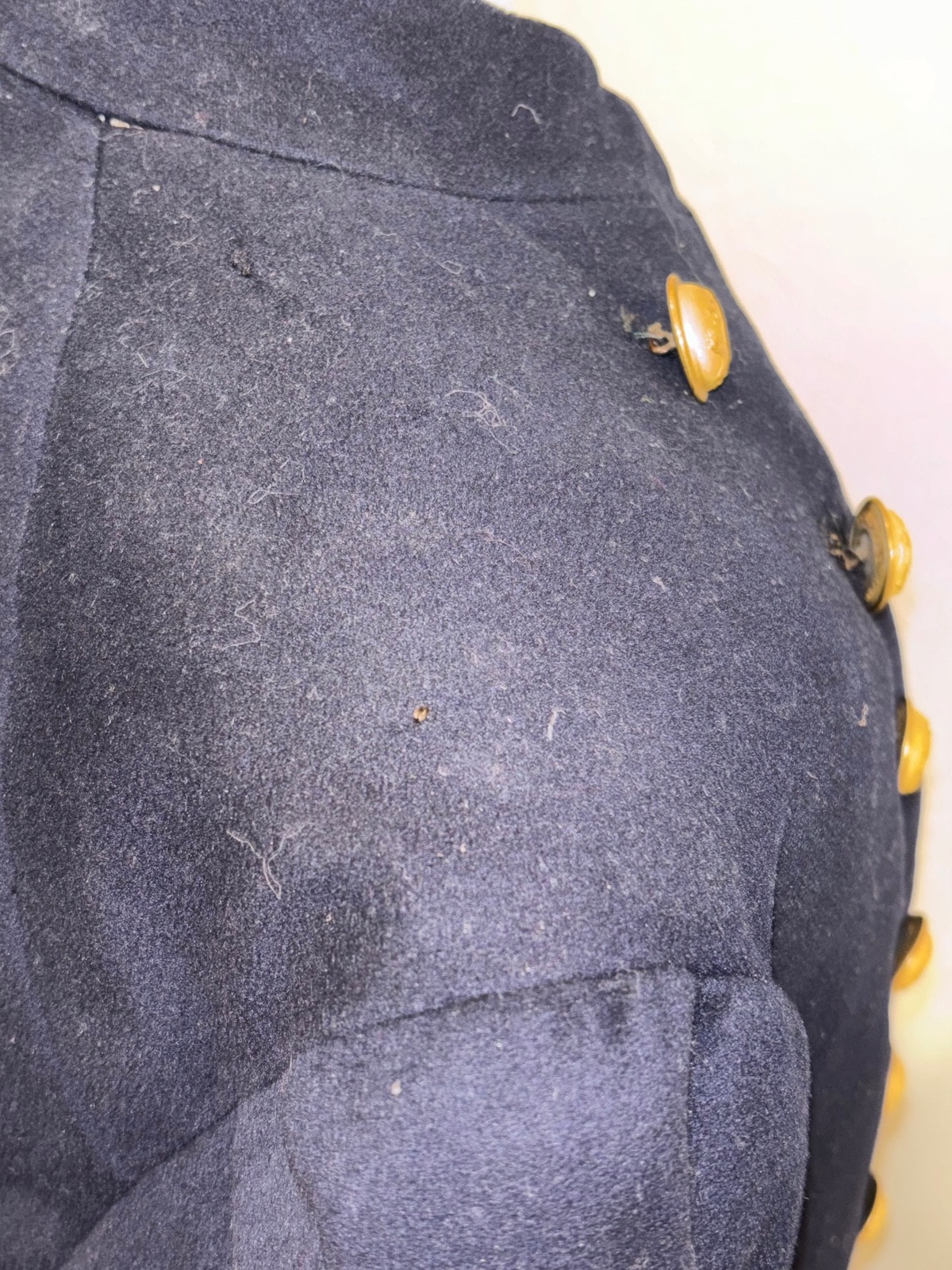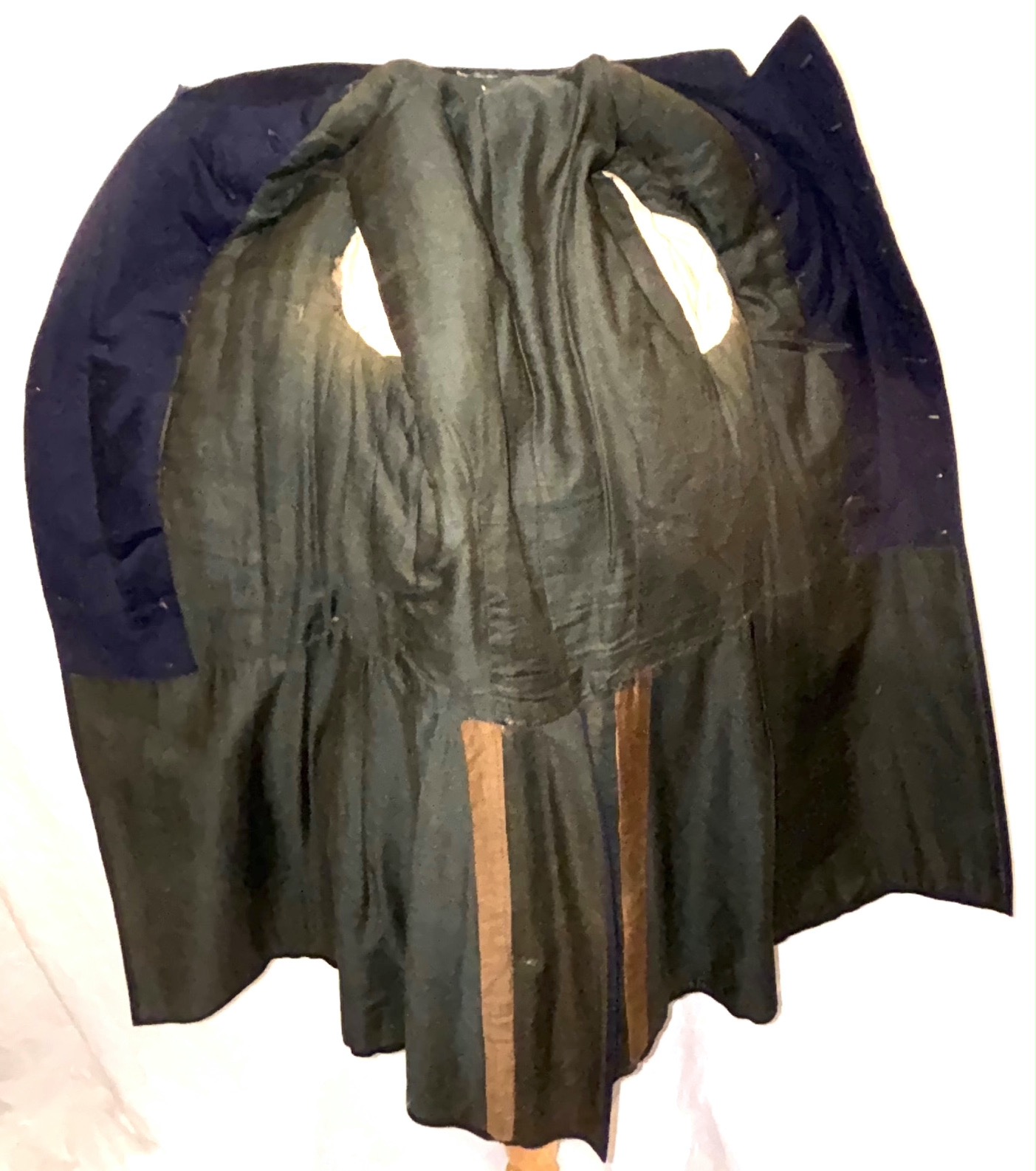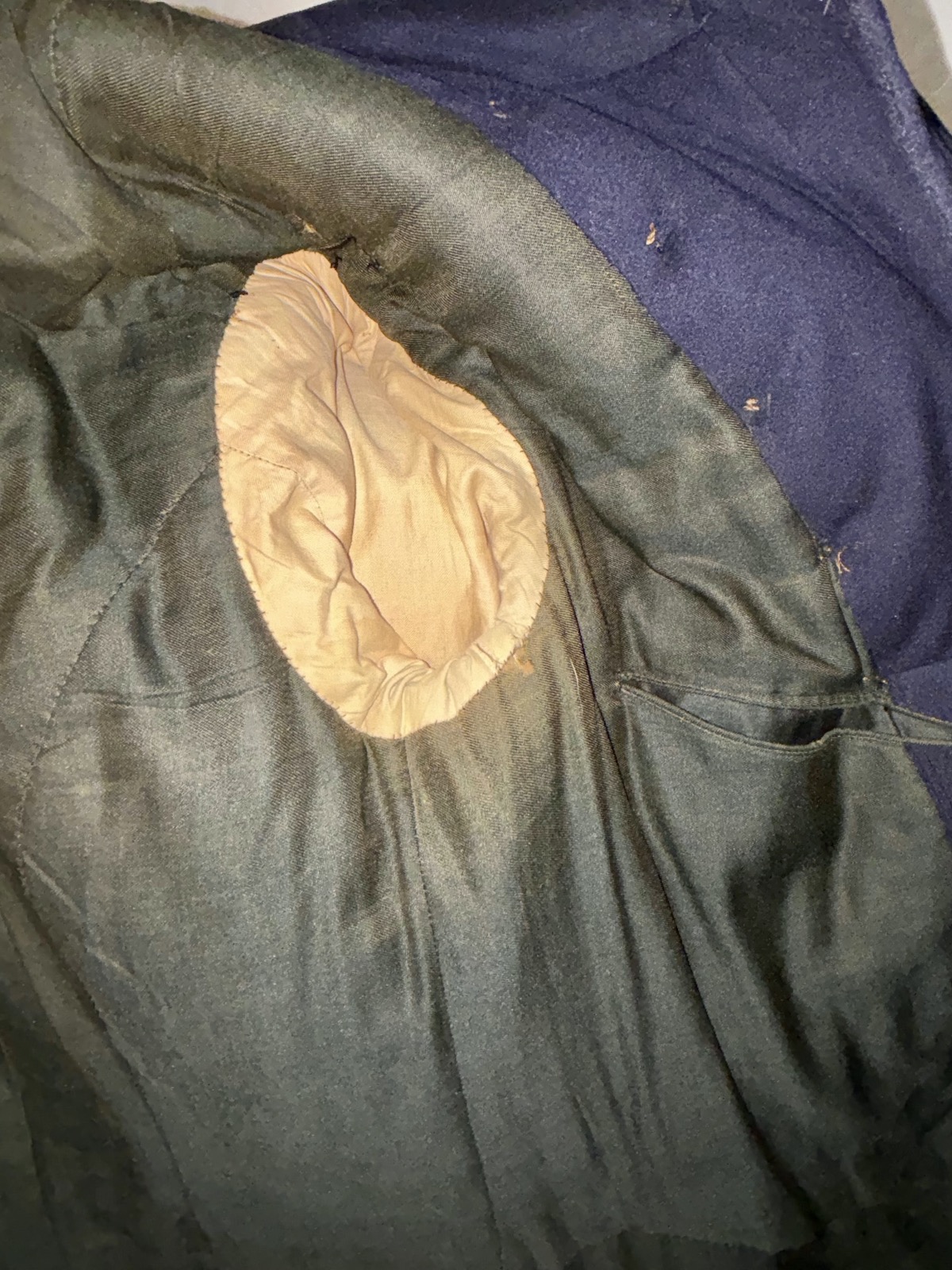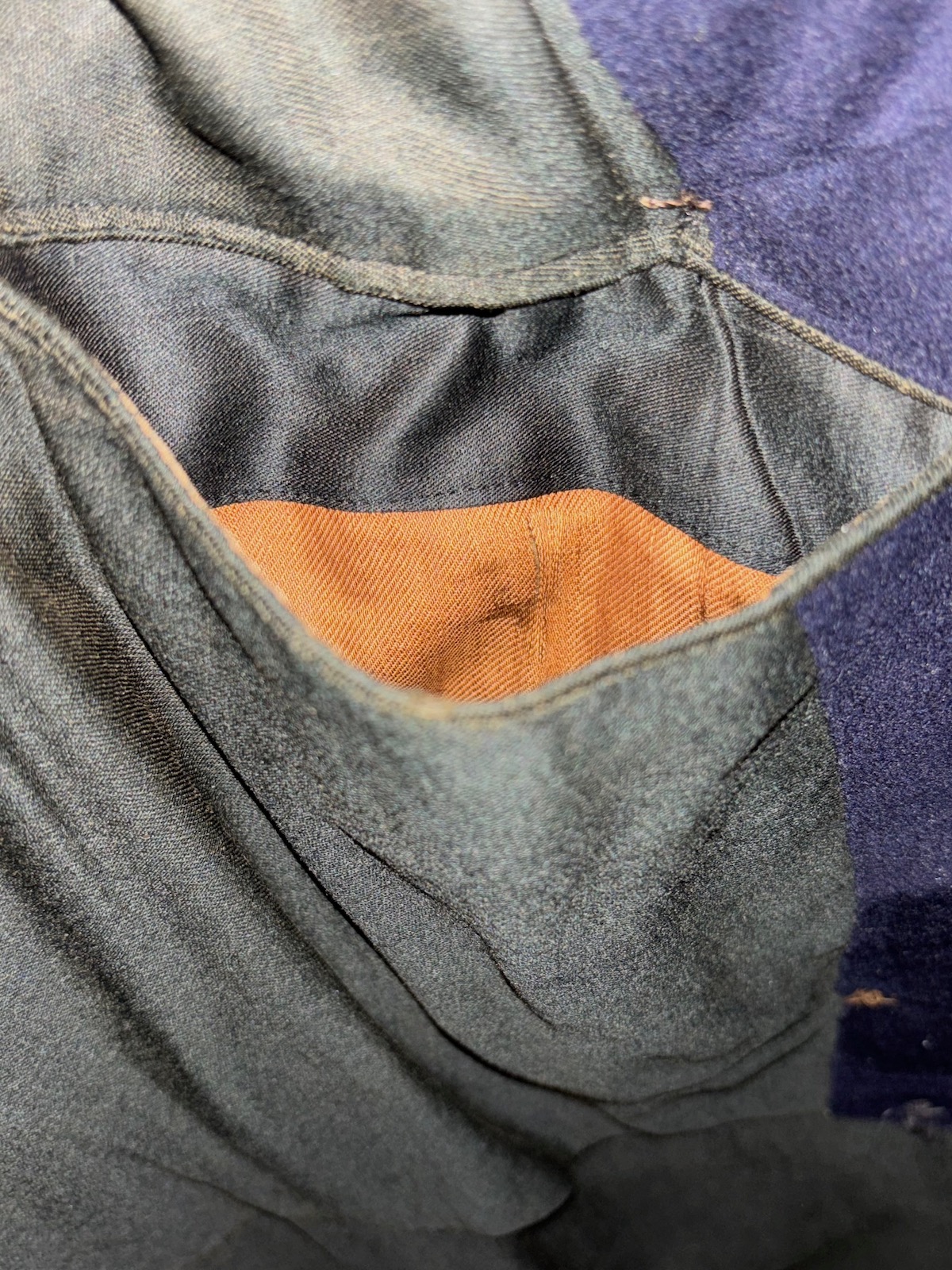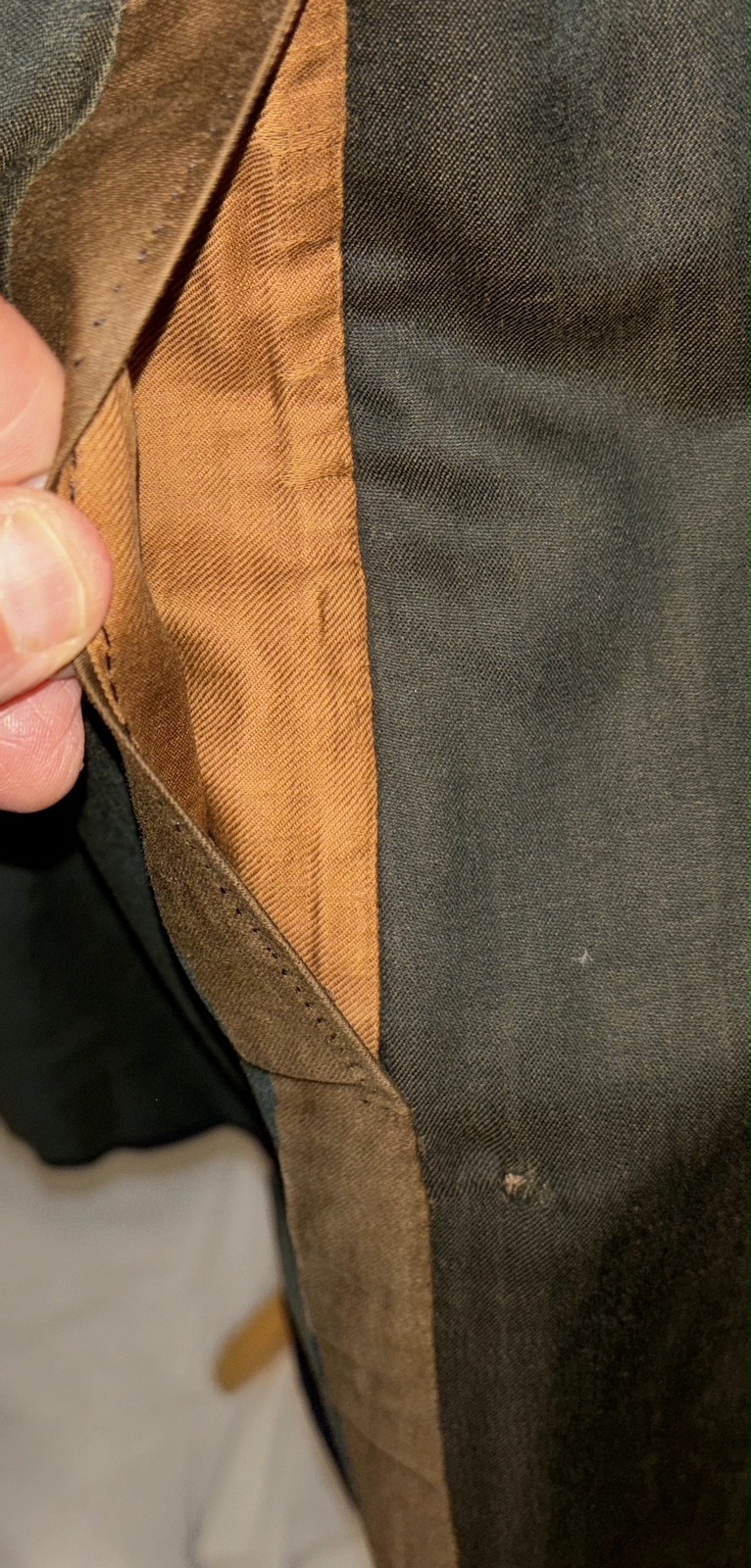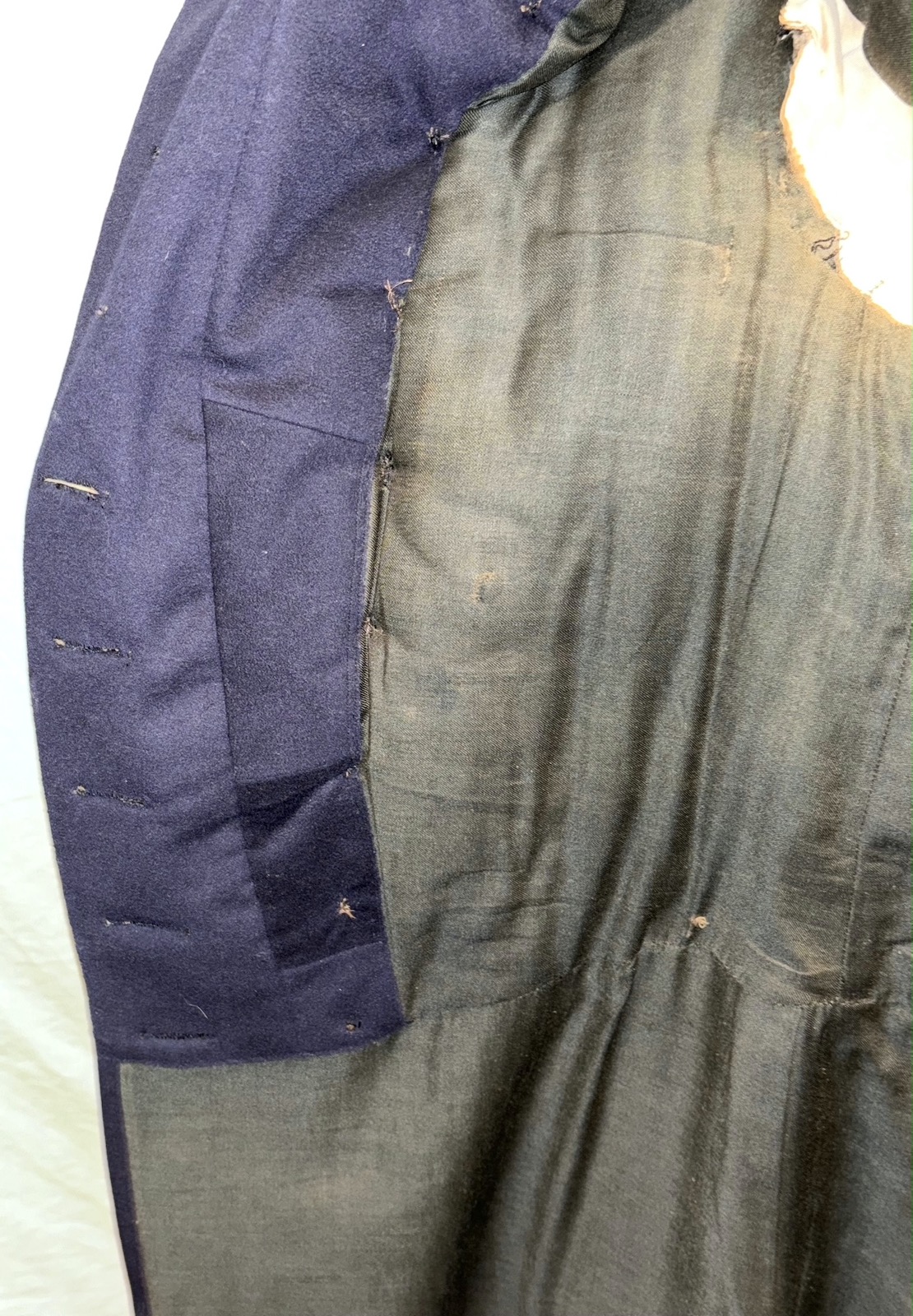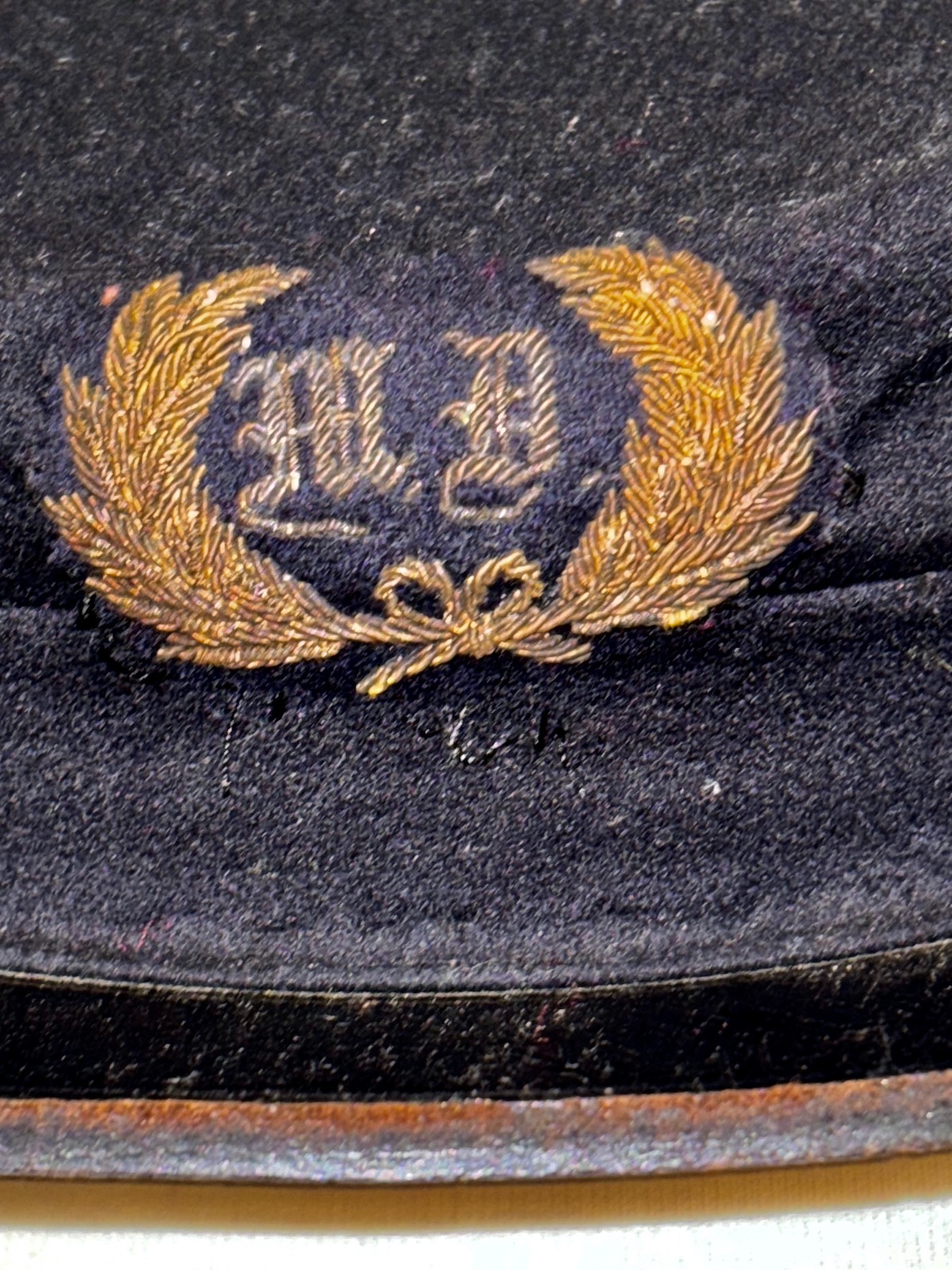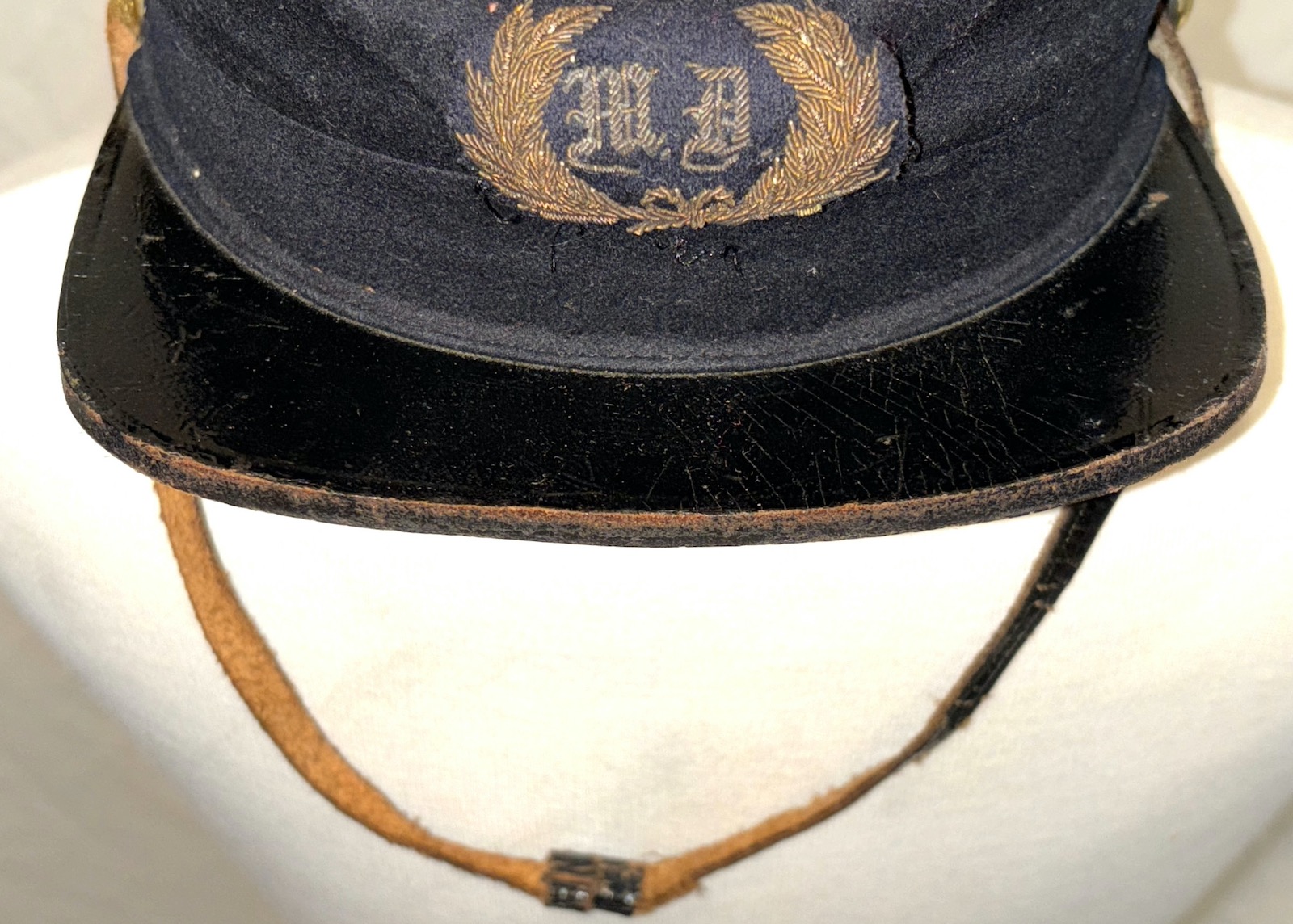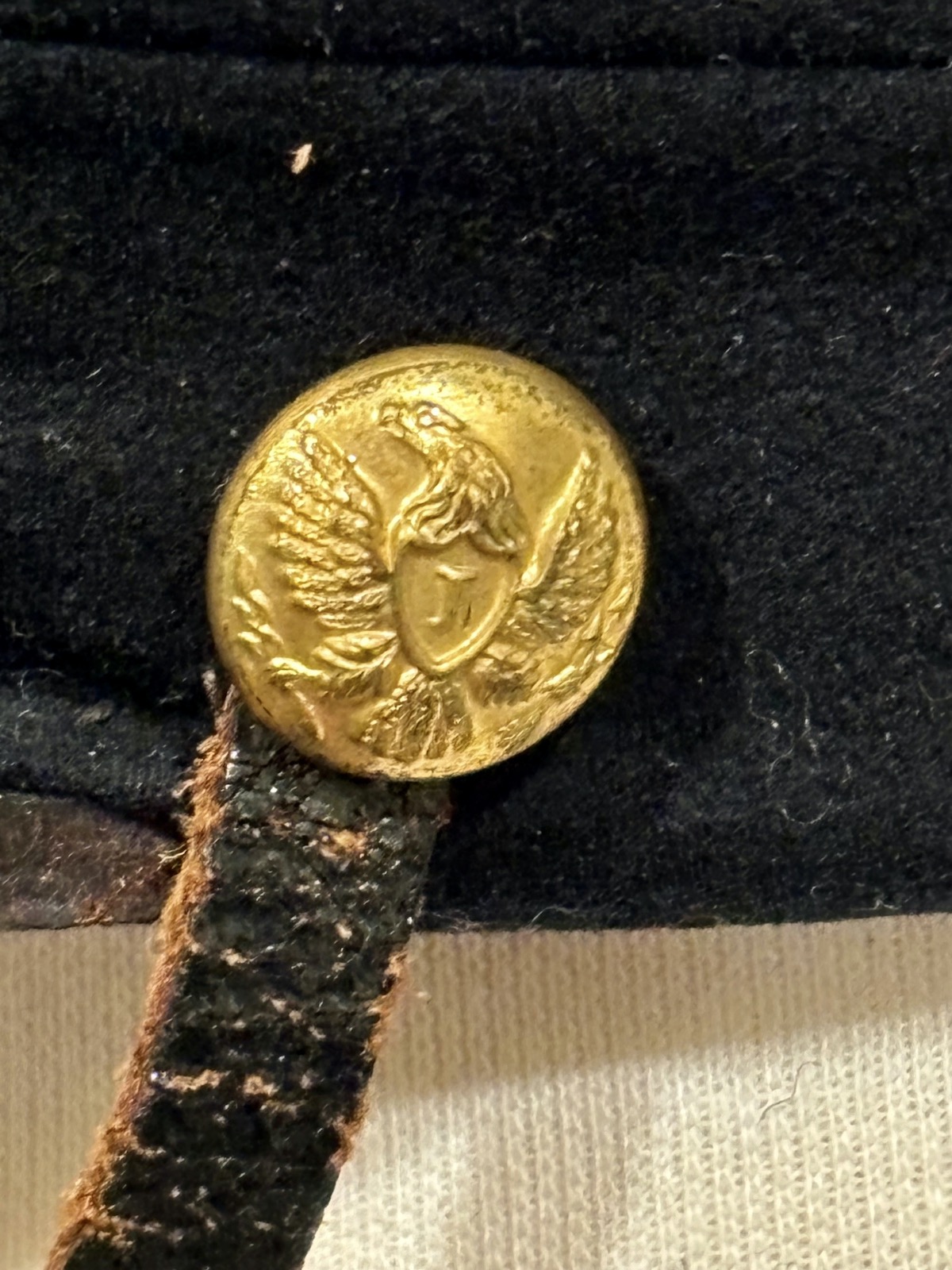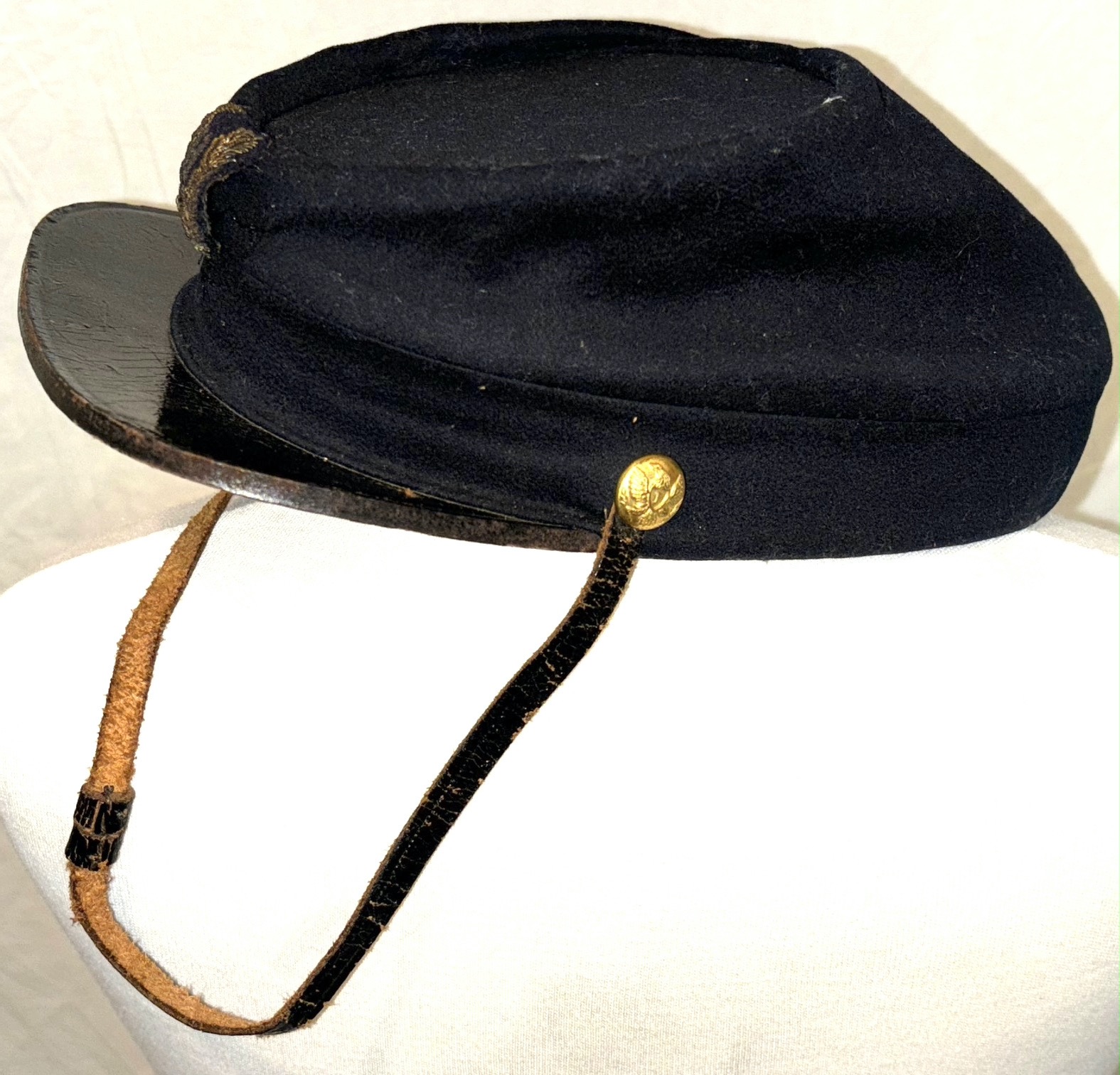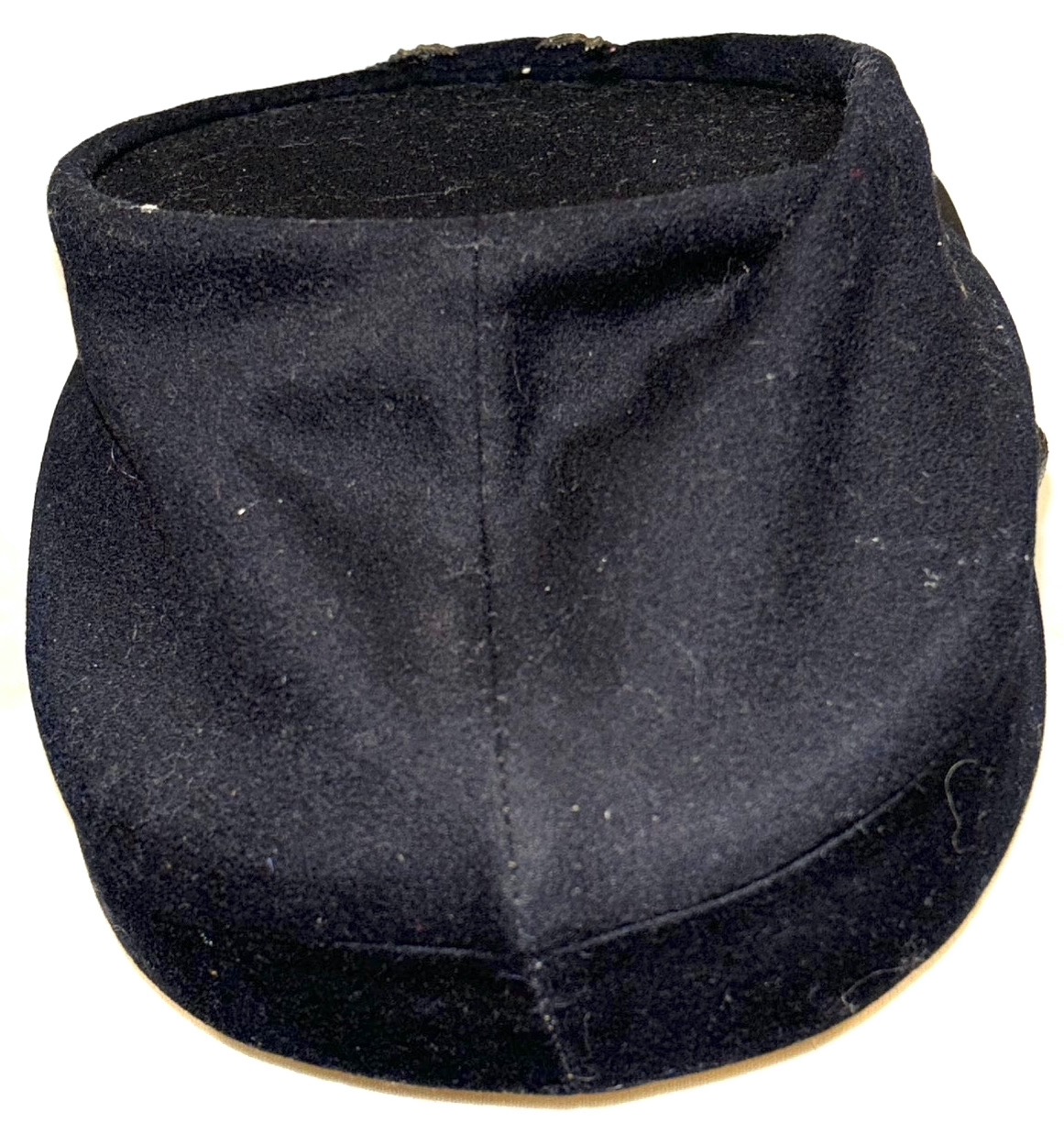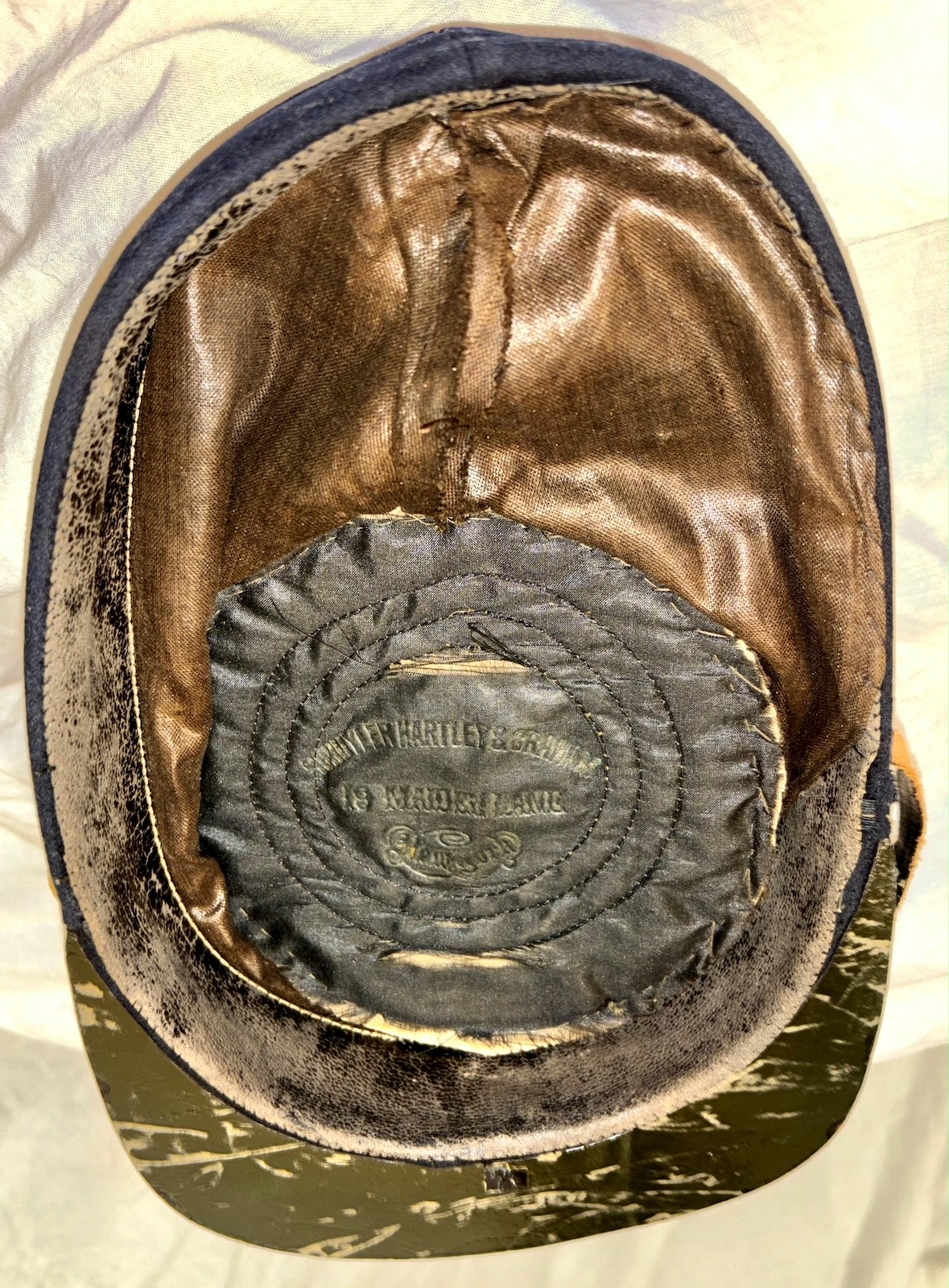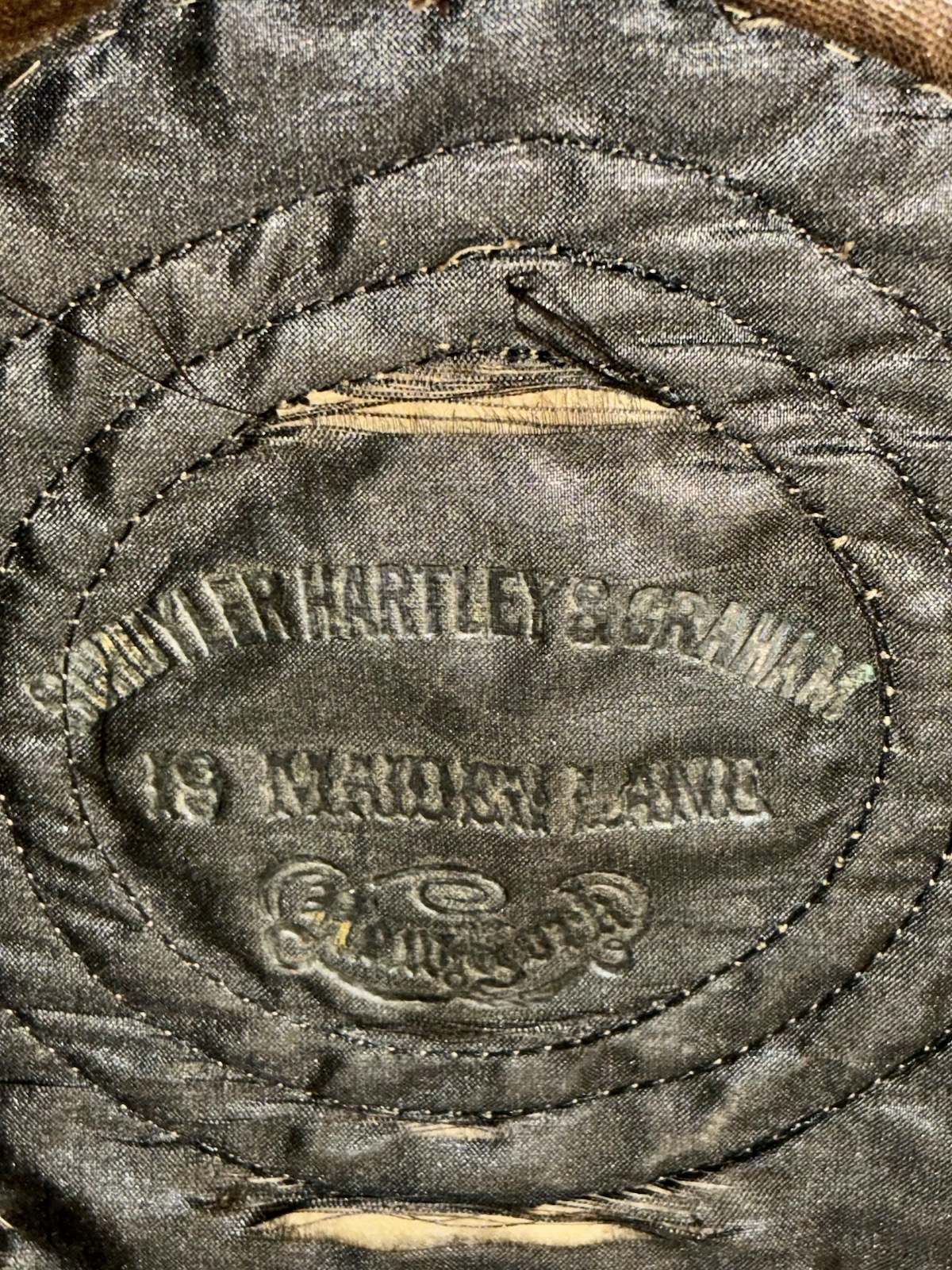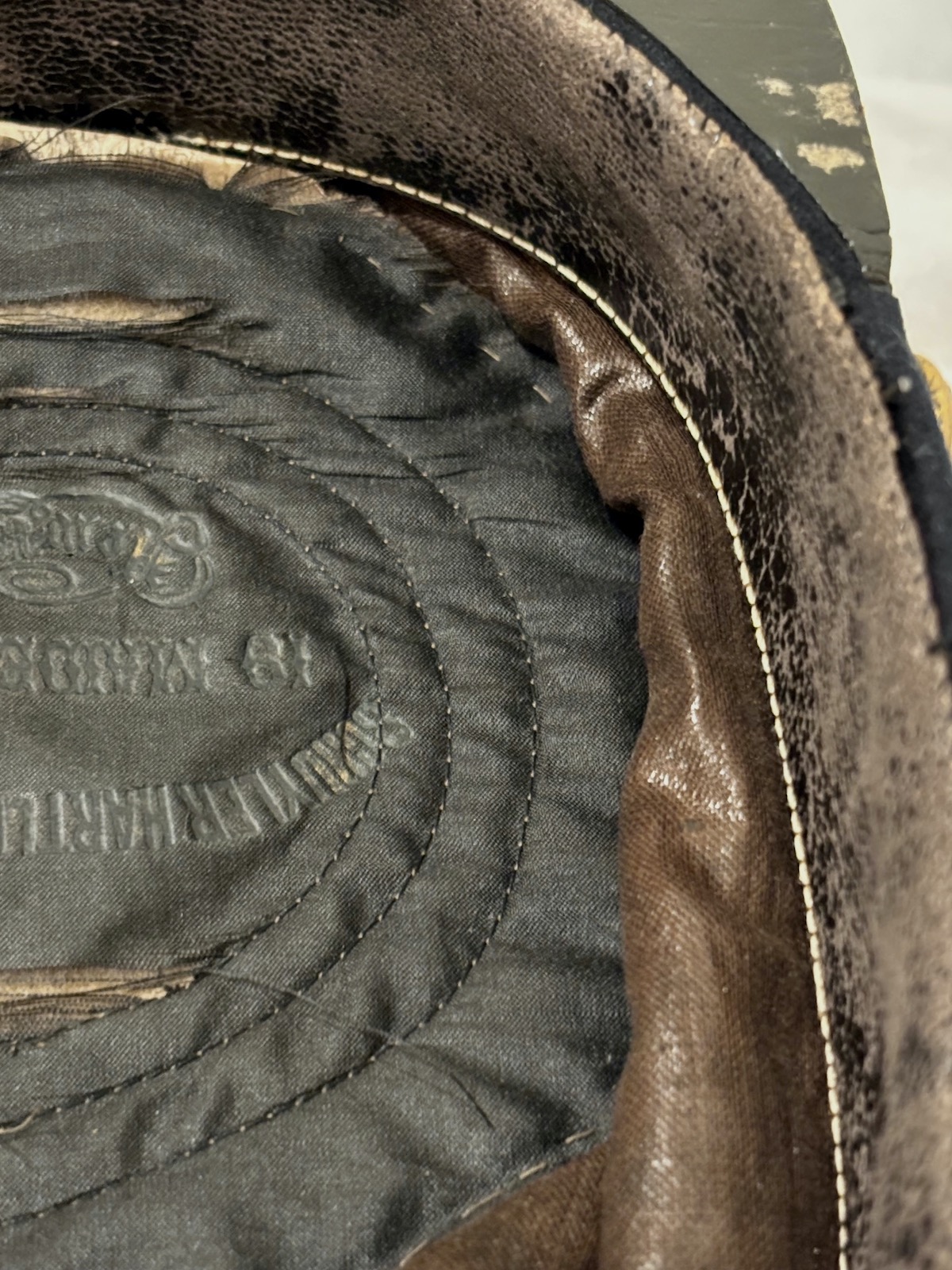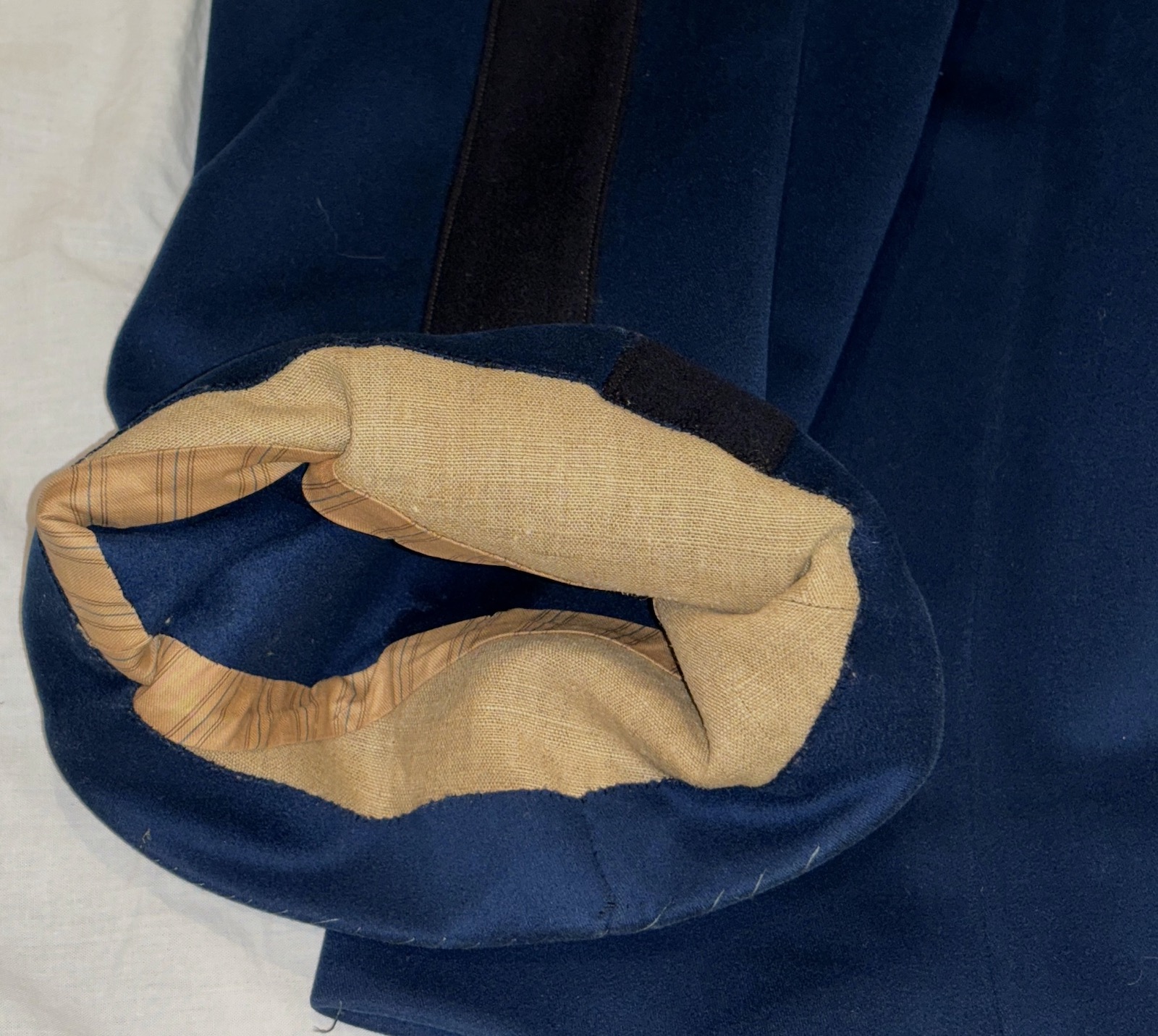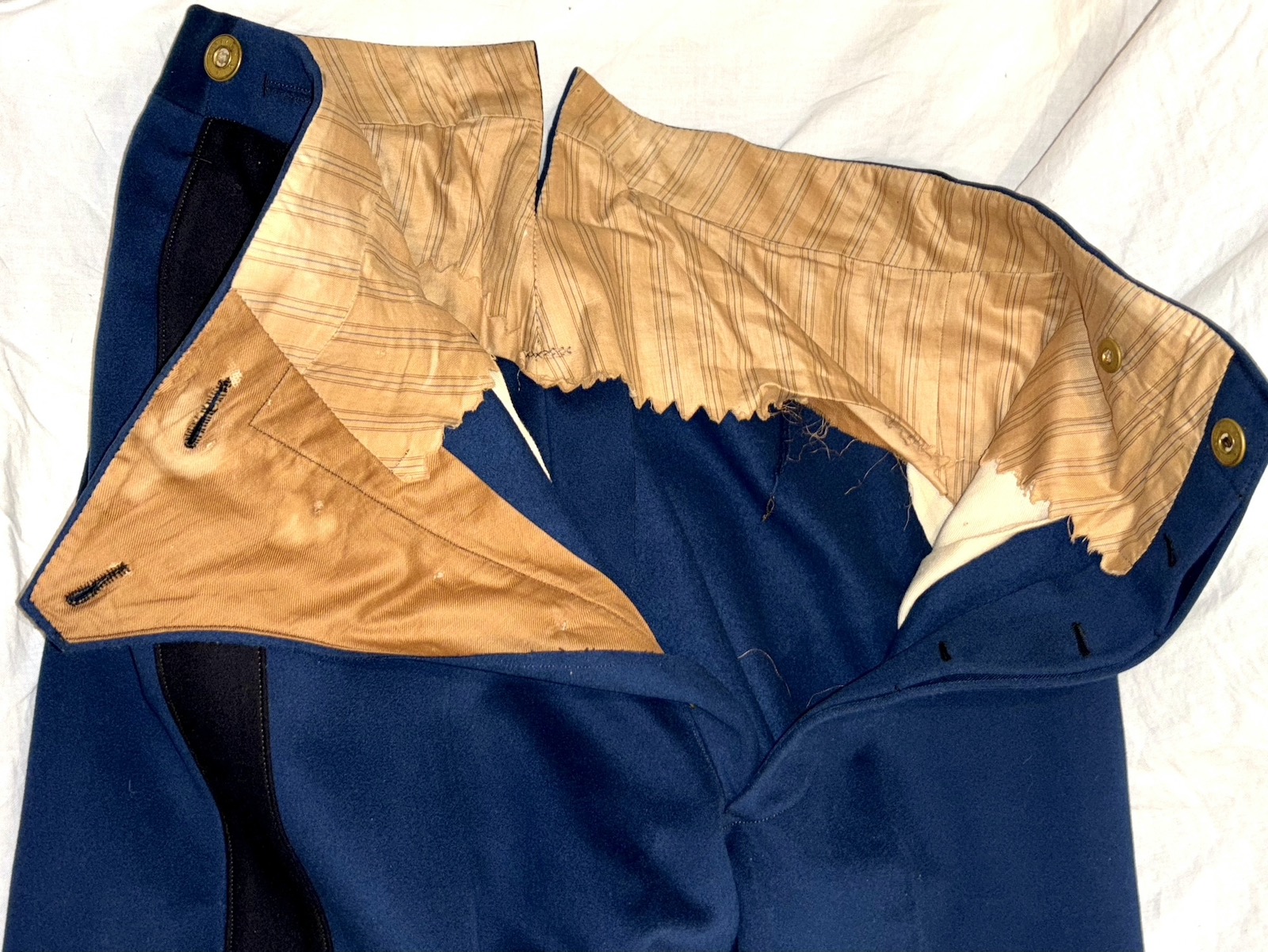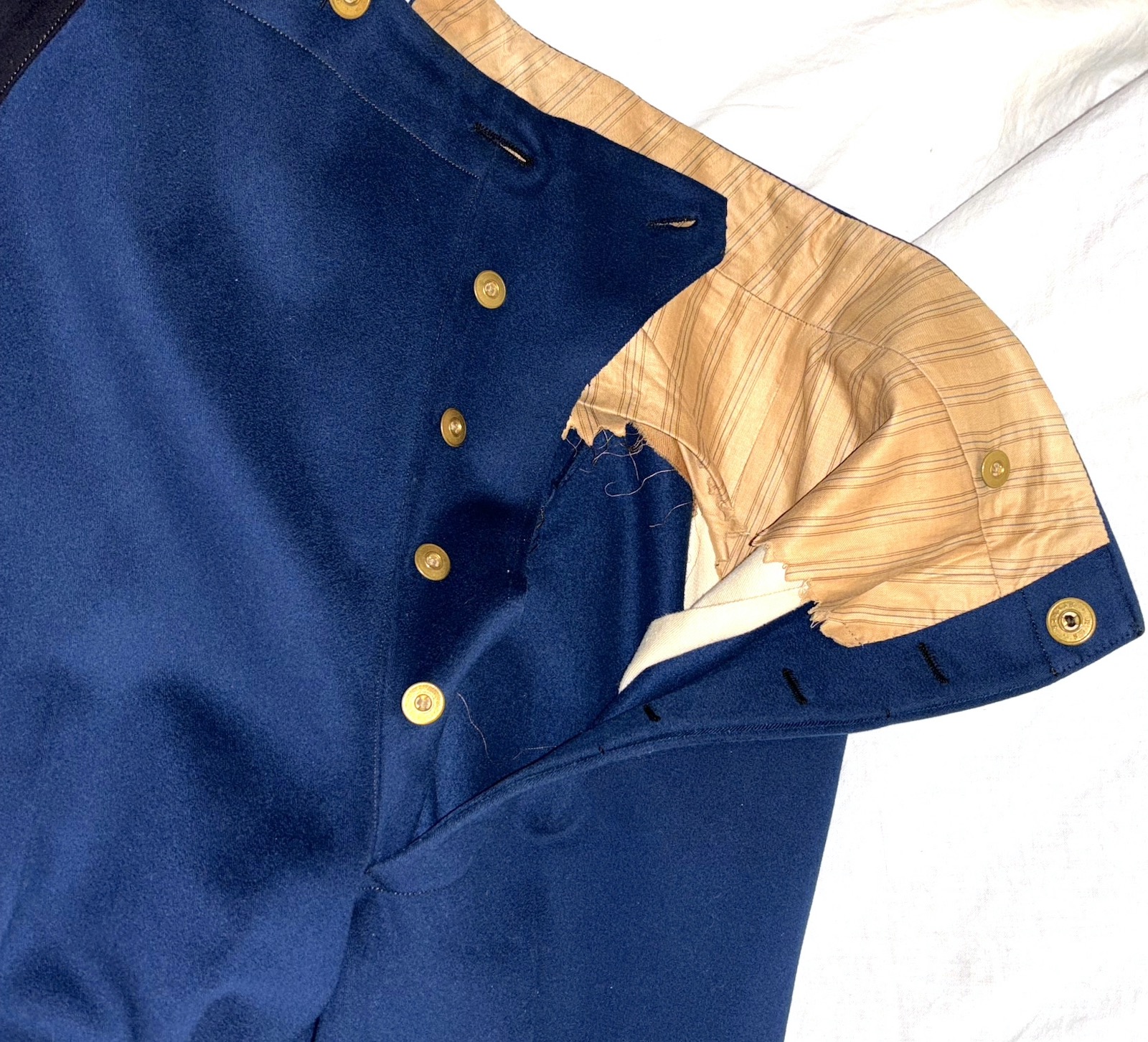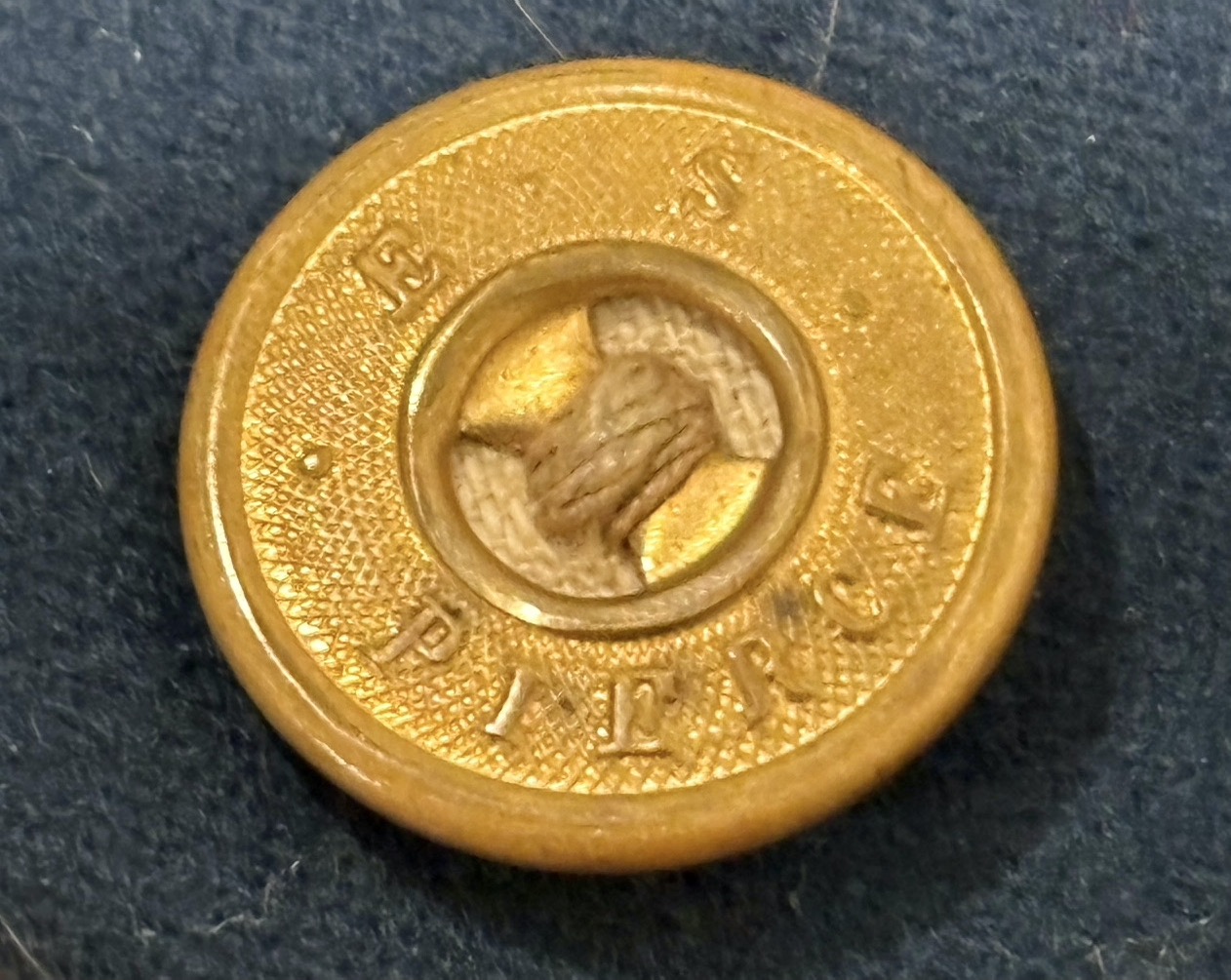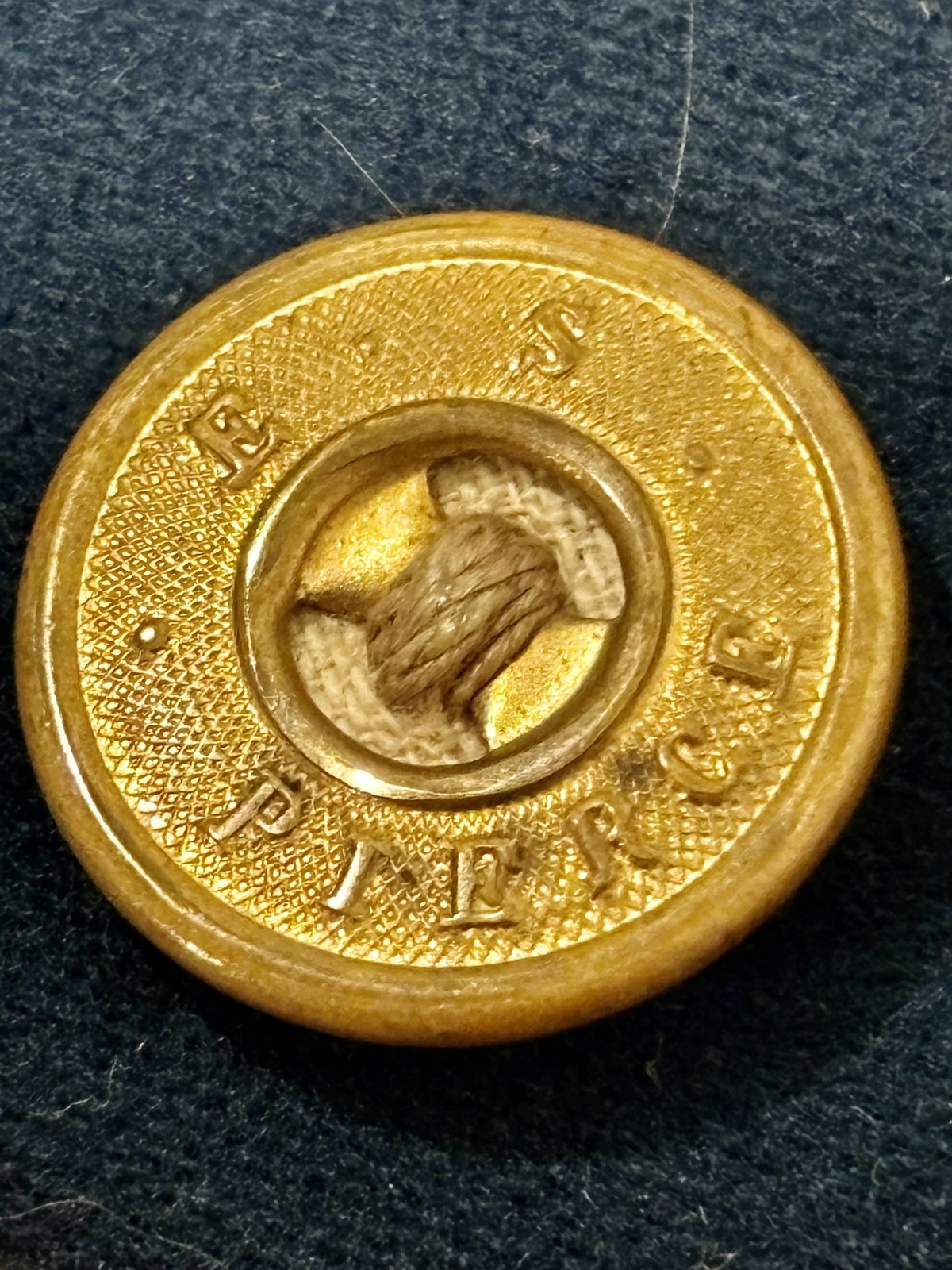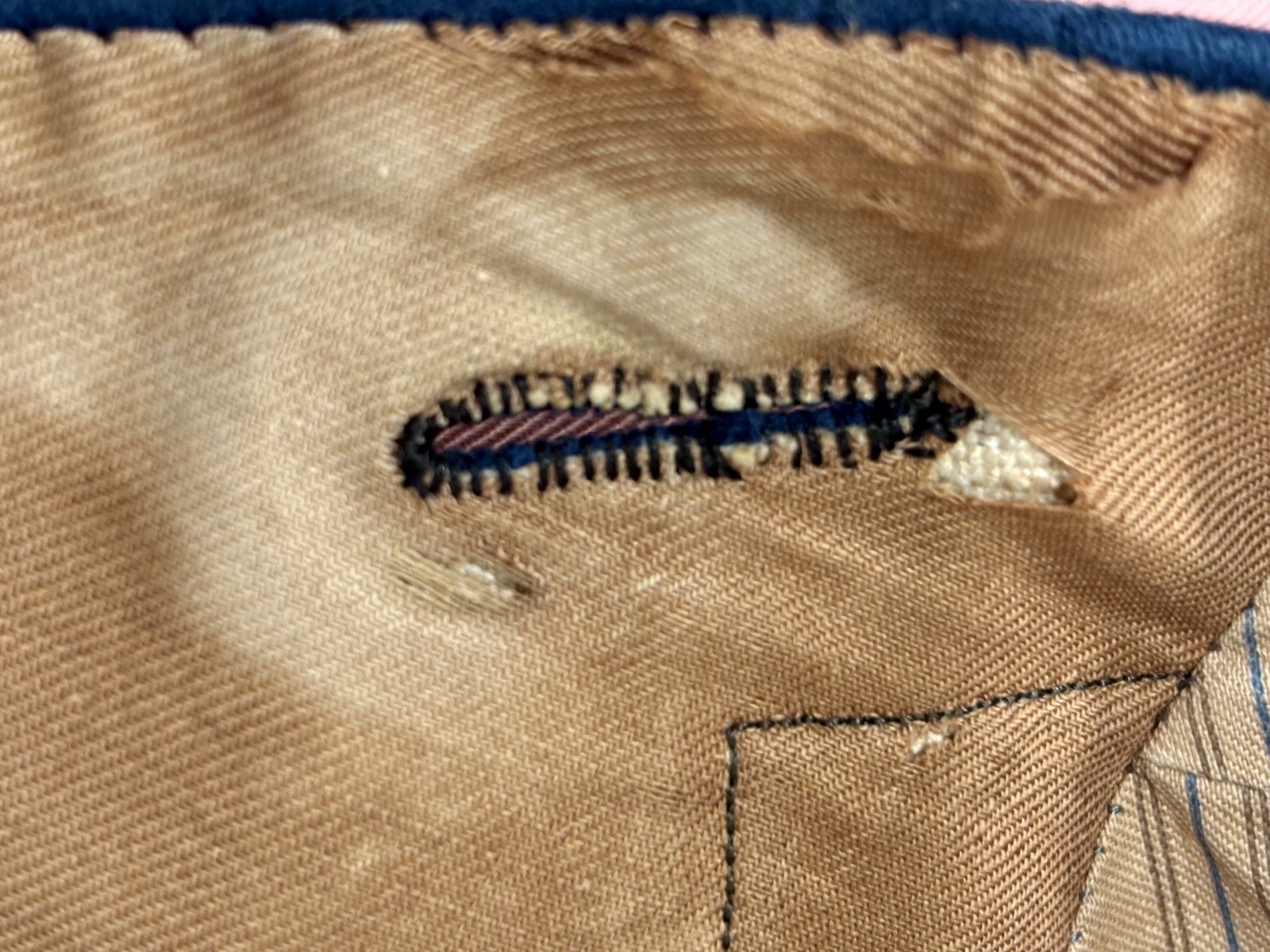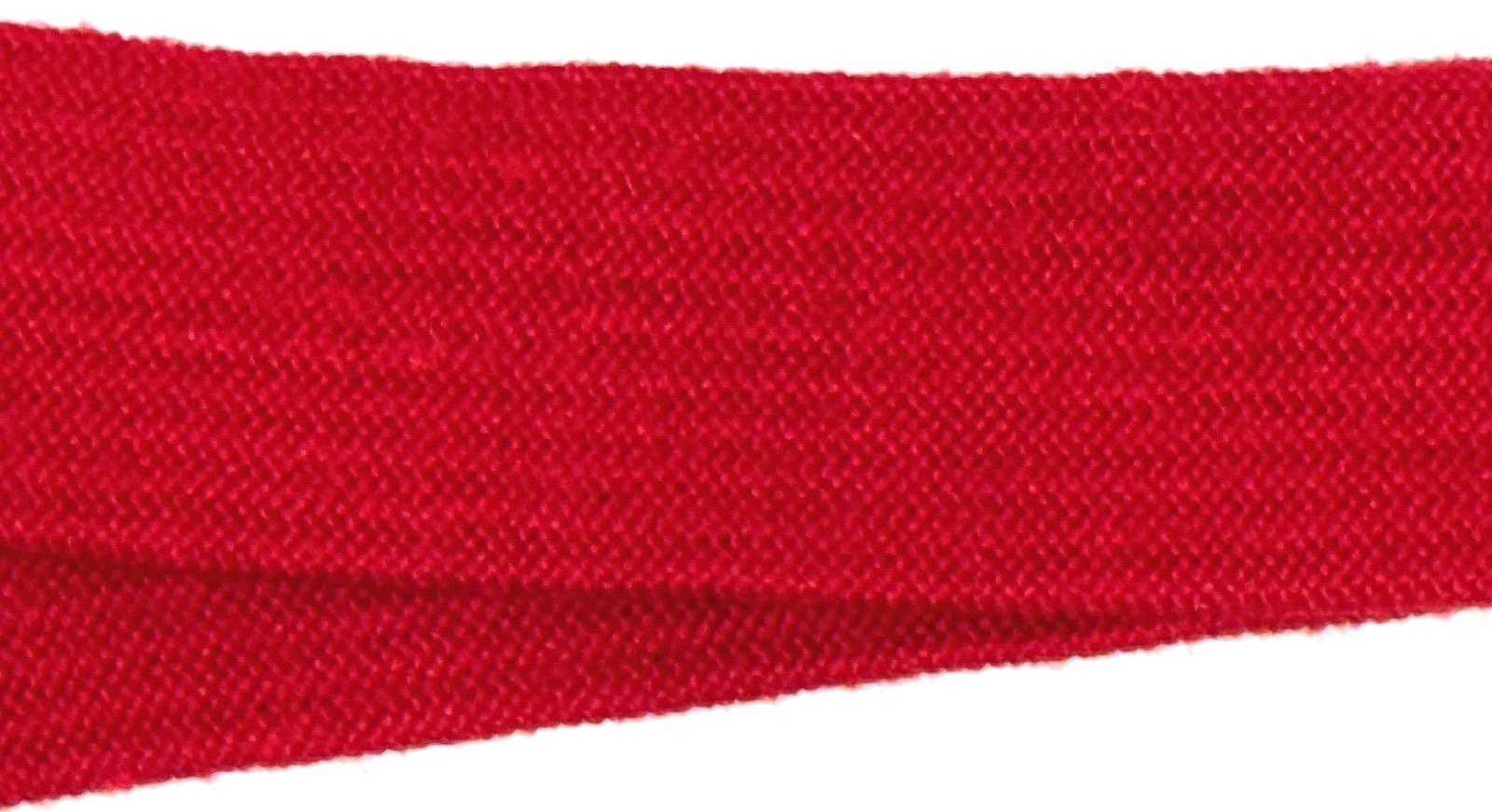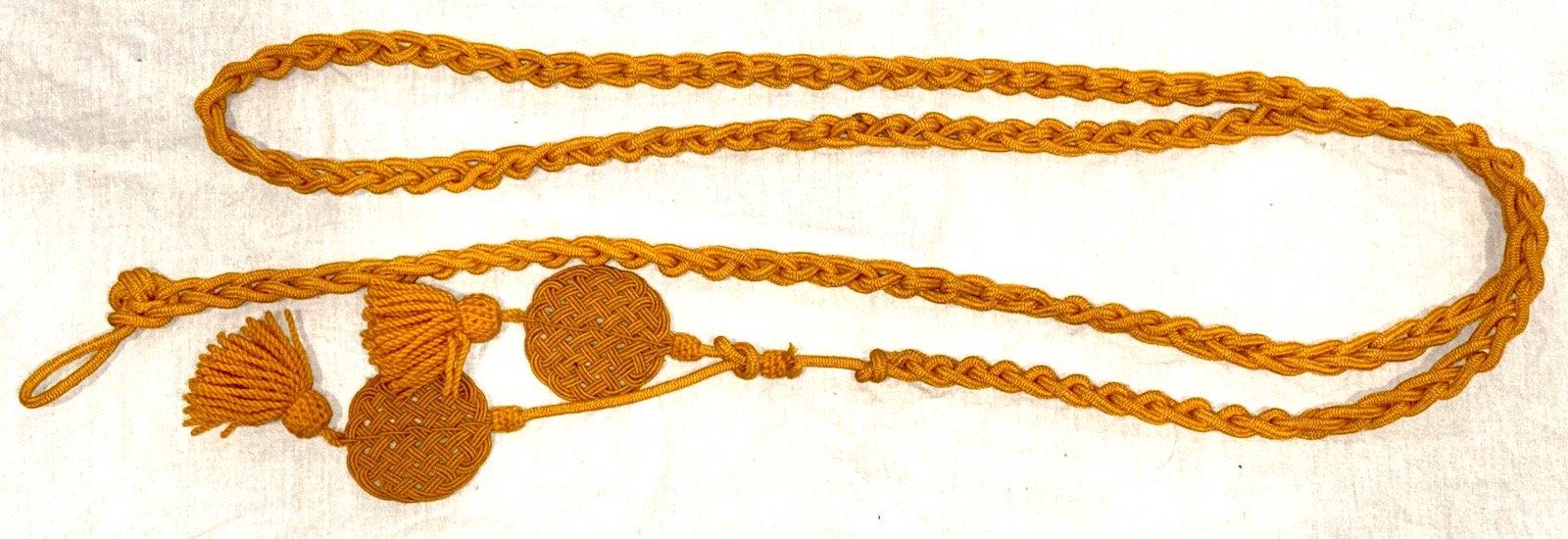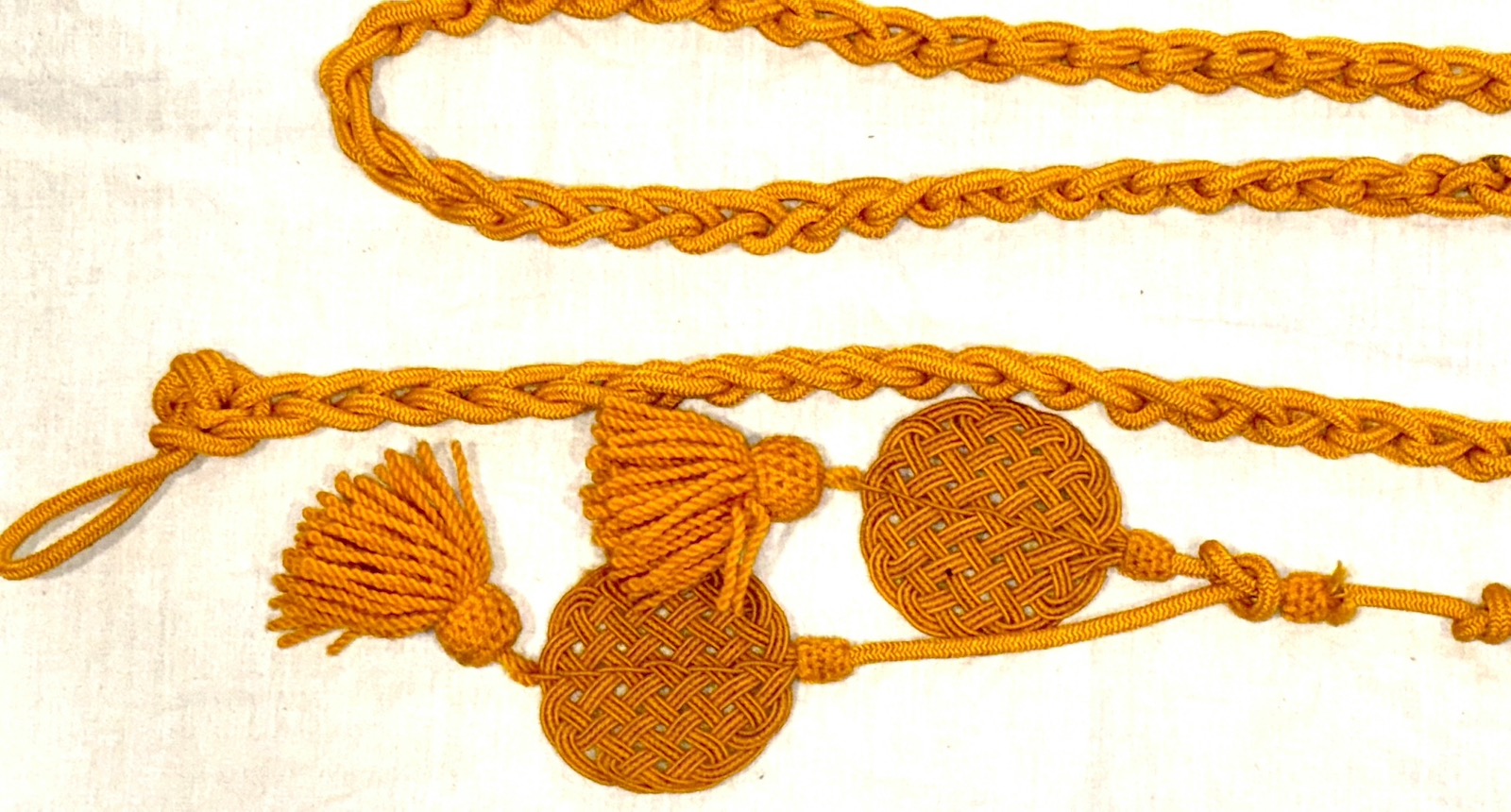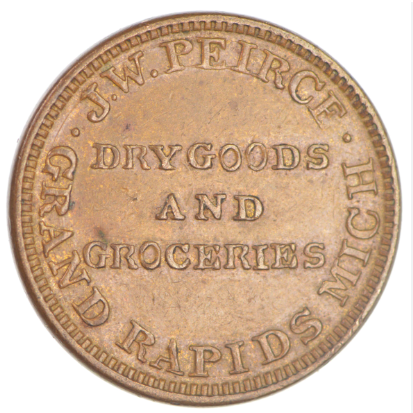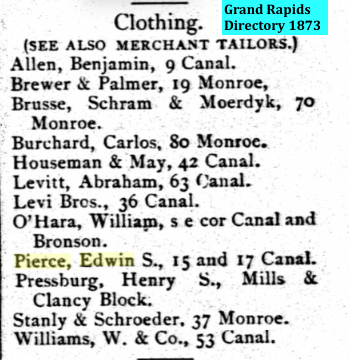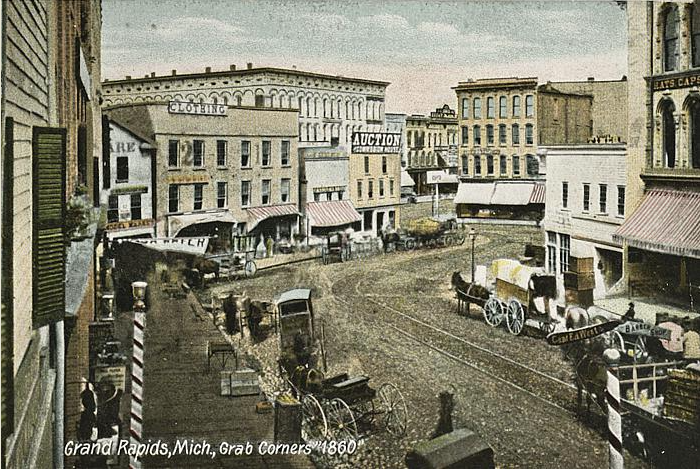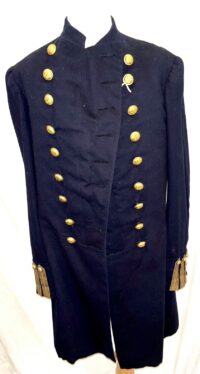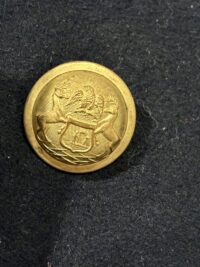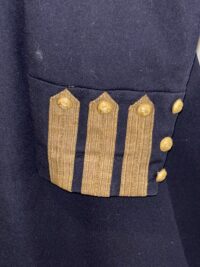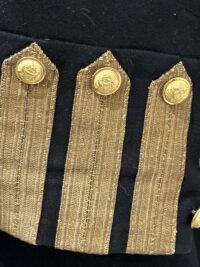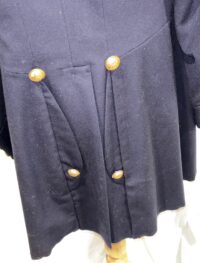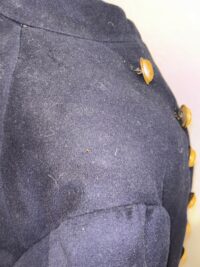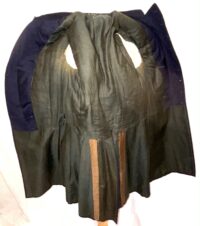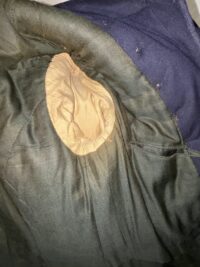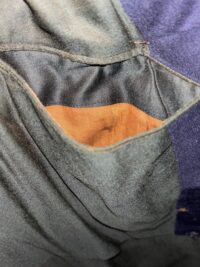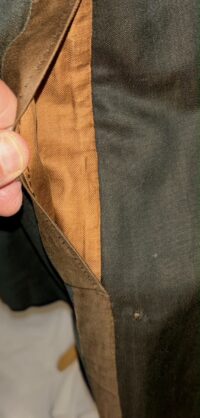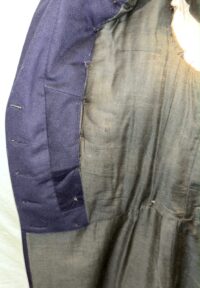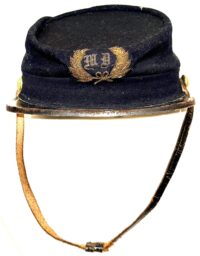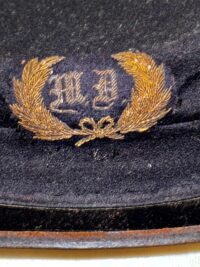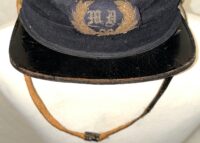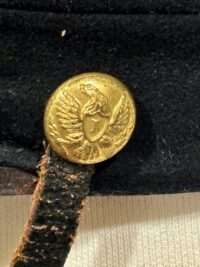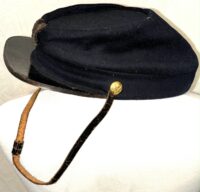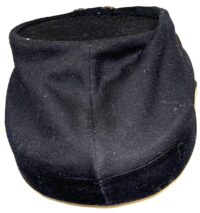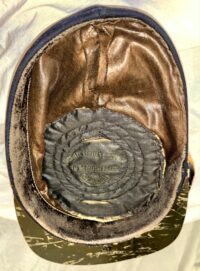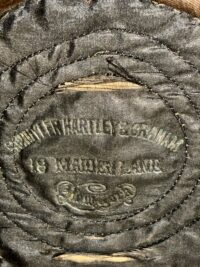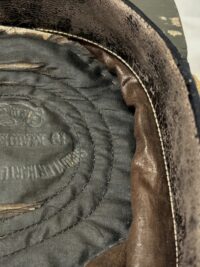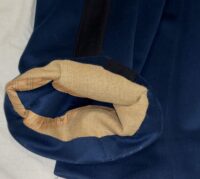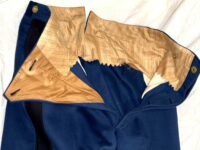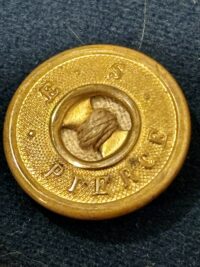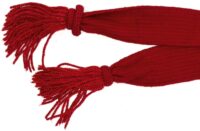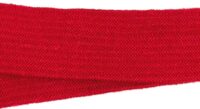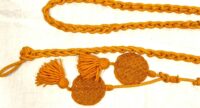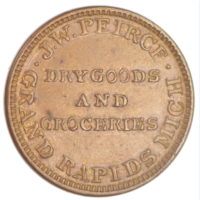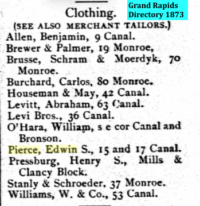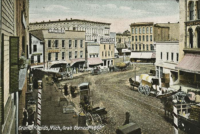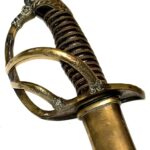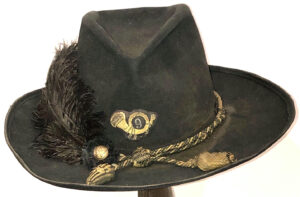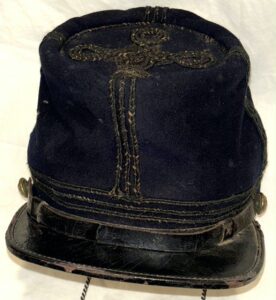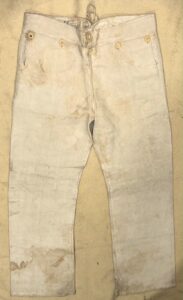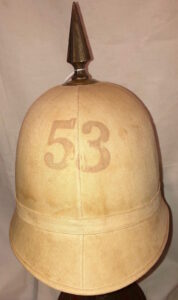U.S. Regulation of 1874 Officer’s Frock Coat, Pants and Cap Made by Edwin S. Pierce Civil War Veteran Lt. Col. of the 3rd Michigan Infantry
$1,750
U.S. Regulation of 1874 Officer’s Frock Coat, Pants and Cap Made by Edwin S. Pierce Civil War Veteran Lt. Col. of the 3rd Michigan Infantry – This superior condition grouping was made at the postwar, tailor shop of Edwin S. Pierce; Pierce had served with distinction as a Lt. Colonel in the 3rd Michigan Infantry, during the Civil War. The coat, pants and cap conform to the U.S. Army Regulations of 1874; all three elements in this grouping remain in superb condition, with only the most minor of insect impact and retaining vibrant color. All buttons on the coat and cuffs, are Michigan staff officer buttons, by Scovills of Waterbury. The coat, constructed of a high grade of dark blue wool, exhibits a quilted lining and off-white, cotton-lined sleeves and is finely tailored with a combination of hand and machine sewing; there are pockets in the tails of the coat and ballooned elbows, as well as unhemmed skirts, all features indicative of an early, post-Civil War coat. The pants, constructed of a fine quality, wool, retain a great, sky-blue color, with a wide, dark blue, branch of service stripe, down each leg; both hand and machine stitching were utilized in the manufacture of the pants, which are lined, in the interior waist area, with cotton. The pants buttons are all gilded brass, with the tailor’s name – “E. S. Pierce” – embossed in each button. At the cuffs of both pant legs, is a lining to protect the pants from wear and mud, a feature also comparable to Civil War, officer pants. The cap is a low crown, kepi style, dating from the late Civil War to the early 1870s; it is constructed of a high grade of dark blue wool; a bullion insignia affixed to the front of the cap – the letters “MD “ within a bullion wreath. The lining remains in the cap and is constructed of brown polished cotton, along the sides of the interior and quilted, black silk on the interior of the crown; embossed on the crown of the cap is the following:
“SCHUYLER HARTLEY & GRAHAM
18 MAIDEN LANE
NEW YORK”
This well-known firm, a main source for uniforms, edged weapons and insignia, as well as additional military items, during the Civil War, was still at their old, Civil War address, when this cap was retailed by them. The sweat band also remains in place, as does the chinstrap, although it appears to have come unattached at some time and been re-attached on one side of the cap. At the point of attachment of the chinstrap, on either side of the cap’s exterior, are Civil War period, “Eagle I” officer’s cuff buttons. When we obtained the coat there was an old, retailer label, with what appeared to be the name “E. S. Pierce” – that label was in very tenuous condition and is no longer with the coat; we were able to make a photograph of the label which will be included with the purchase of the grouping. Pierce, with other family members, ran a clothing and tailoring establishment in Grand Rapids, Michigan, after the Civil War. Prior to the war, the Pierce brothers Byron, Silas, and Edwin owned a clothing and custom tailor shop, in Grand Rapids. Research indicates that they may have manufactured the uniforms for their Michigan regiment. Note the image attached of the 1861 Pierce, store token. Edwin S. Pierce is listed as a clothier and tailor, in the 1873 Grand Rapids directory. In addition, the gold washed pants buttons all are embossed with the following:
Edwin S. Pierce served in the 3rd Michigan Infantry, at the rank of Lt. Colonel. While serving in this regiment, Pierce would see considerable action, throughout the war.
Many collectors consider the U.S. M1874 Officer’s Frock Coat more difficult to find today, then the standard Civil War, Union officer’s frock coats. The quality of this coat and pants are indicative of their being a custom, tailored order in the early 1870s. Accompanying the coat, pants and cap are an officer’s of the day, scarlet, woven wool, shoulder sash and a bright yellow aiguillette, both dating to the early 1870s. It appears that Edwin Pierce was investing in the resurgence of interest in maintaining state troops, in Michigan, in the early 1870s.
*At the end of 1872, the state’s military force consisted of nine companies. However, during 1873-74, seven more companies were added, forming two regiments (the First and Second) of eight companies each. After the Civil War, people’s prevalent thought seemed to be that war was so terrible there would never be another among civilized people. Thus, all military organizations became suspect. There were still some companies organized though, and it was the habit of these independent companies to go on little tours of camp duty each year by themselves. For example, in 1867, the Light Guard camped at Orchard Lake and in 1869 at Whitemore Lake.
Despite the sincerity of these troops, in 1870 the affairs of the militia were at such a low ebb there were only three companies in state service. These units, anxious to maintain their existence, obtained Governor Baldwin’s approval to hold a joint encampment in August 1870, at Slocum’s Island. This encampment aroused the interest of the public and the state militia began to grow again.
Birth of the Michigan State Troops – The Franco-Prussian War of 1870 also fueled the public’s interest in the state militia. The conflict had such an effect the legislature passed an act authorizing the establishment of the “Michigan State Troops.” The plan was to take existing volunteer companies and, if they desired, incorporate them into the Michigan State Troops. The organization was similar to the National Guard, as far as the state was concerned. In 1891, the name was changed to Michigan National Guard. The organization of volunteer companies was finally recognized as a sensible and logical move, so upon the reorganization of 1870, the old idea of the “militia” was dropped and total reliance for state defense was placed upon the Michigan State Troops. Units in the following cities were once part of the Michigan State Troops, and are still active in the Michigan National Guard today: Ann Arbor, Adrian, Jackson, Lansing, Ypsilanti, Coldwater, Grand Rapids, Muskegon, and Calumet.
At the end of 1872, the state’s military force consisted of nine companies. However, during 1873-74, seven more companies were added, forming two regiments (the First and Second) of eight companies each.
- Letter designations, locations, and original dates of muster of the First Regiment, under Colonel William H. Withington, of Jackson, were as follows:
–Company A, Detroit, November 16,1855
–Company B, Ann Arbor, September 22, 1868
–Company C, Detroit, March 25, 1870
–Company D, Adrian, August 15, 1970
–Company E, Tecumseh, December 29,1870
–Company F, Monroe, December, 29,1870
–Company G, Hudson, April 1, 1872
–Company H, Ypsilanti, December 25,1872
- Letter designations, locations, and original dates of muster of the Second Regiment were as follows:
–Company A, Coldwater, November 17,1871
–Company B, Flint, October 18, 1872
–Company C, Grand Rapids, November, 26,1872
–Company D, Kalamazoo, March 4,1873
–Company E, Bay City, April 18, 1874
–Company F, East Saginaw, April 13,1872
–Company G, Port Huron, April 16, 1874
–Company H, Marquette, July 24,1874.
During the years between the 1870 reorganization and the Spanish-American War in 1898, the State Troops increased in number, efficiency, and preparedness. New units were added and those that dropped below standards were disbanded. By 1876, the State Troops’ strength stood at 1,792 and was organized into 24 companies. Rifle practice was emphasized and the soldiers participated in many civil celebrations and parades and aided the civil authorities in keeping law and order on several occasions.
*Department of Military and Veterans Affairs – Lansing, Michigan
| Name: | Edwin S Pierce | ||||||||||||||||||
| Age: | 28 | ||||||||||||||||||
| Birth Year: | 1832 | ||||||||||||||||||
| Gender: | Male | ||||||||||||||||||
| Race: | White | ||||||||||||||||||
| Birth Place: | New York | ||||||||||||||||||
| Home in 1860: | Grand Rapids Ward 3, Kent, Michigan | ||||||||||||||||||
| Post Office: | Grand Rapids | ||||||||||||||||||
| Dwelling Number: | 1141 | ||||||||||||||||||
| Family Number: | 999 | ||||||||||||||||||
| Occupation: | Clerk | ||||||||||||||||||
| Inferred Spouse: | Mary E Pierce | ||||||||||||||||||
| Household Members: |
|
||||||||||||||||||
| Name: | Edwin S Pierce | ||||||||||||||||||
| Gender: | Male | ||||||||||||||||||
| Rank: | Captain | ||||||||||||||||||
| Role: | Veteran | ||||||||||||||||||
| Residence Date: | Jun 1890 | ||||||||||||||||||
| Residence Place: | Grand Rapids, Kent, Michigan, USA | ||||||||||||||||||
| Enumeration District: | 149 | ||||||||||||||||||
| Enlistment Date: | 13 May 1861 | ||||||||||||||||||
| Discharge Date: | 20 Jan 1864 | ||||||||||||||||||
| Regiment or vessel: | 3 M. Inf | ||||||||||||||||||
| Length of Service: | 2 Yrs 8 Mos 7 Days | ||||||||||||||||||
| Household: | 1 |
3rd Michigan Infantry Regiment
The 3rd Michigan Infantry Regiment had a total enrollment of 1,432 men. The regiment lost 4 officers and 154 enlisted men killed or mortally wounded and 2 officers and 89 enlisted men to disease during the Civil War. It is honored by a monument at Gettysburg.
| 1861 | |
| May 21 | Organized at Cantonment Anderson at the Kent County agricultural fairgrounds in Grand Rapids, Michigan, and mustered into State service |
| June 10 | Mustered 1.040 men into United States service under Colonel Daniel McConnel, Lieutenant Colonel Ambrose A. Stevens, Major Stephen Champlin and Adjutant Edward S. Earle.
· Company A – “Valley City Guards” – Kent County – Captain Samuel A. Judd · Company B – “Grand Rapids Artillery” – Kent County – Captain Baker Bordan · Company C – “Grand Rapids German Rifles” – Kent County – Captain Adolph Birkenstock · Company D – “Boston Light Guards” = Ionia County – Captain Moses B. Houghton · Company E – “Lyons Light Guards” – Kent County – Captain Edwin S. Pierce · Company F – “Union Guards” – Kent County – Captain John J. Dennis · Company G – “Williams Rifles” – Ingham and Wayne Counties – Captain John R. Price · Company H – “Muskegon Rangers” – Muskegon County & Ottawa County – Captain Emery D. Bryant · Company I – “Lamont and Georgetown Rifles” – Captain George Weatherwax · Company K – Kent County – Captain Byron R. Pierce |
| June 13 | Left Michigan for Washington, D.C., travelling on two trains on the Detroit & Milwaukee Railroad to Detroit. Here they transferred to two boats for an overnight trip to Cleveland. |
| June 14 | Left Cleveland by rail for Washington via Pittsburg, Harisburg and Baltimore. |
| June 16 | Arrived in Washington and marched to Chain Bridge, where camp was set up on the bluffs overlooking the Potomac. Attached to Richardson’s Brigade, Tyler’s Division, McDowell’s Army of Northeastern Virginia for Duty in the Defenses of Washington, D.C. |
| July 1 | William Choates of company C died of disease and was buried at Camp Blair, the first member of the regiment to die. |
| July 16 | Advance on Manassas, Virginia. |
| July 16-21 | Occupation of Fairfax Court House, Virginia. |
| July 17 | Action at Blackburn’s Ford |
| July 18 |
Battle of Bull Run (Manassas)The regiment was in reserve and helped cover the retreat of the Federal army. |
| July 21 | Duty in the Defenses of Washington, D.C. |
| August | Attached to Richardson’s Brigade, Division of the Potomac |
| October 21-24 | Reconnaissance to Occoquan |
| October 22 | Colonel McConnel resigned for medical reasons. |
| October 28 | Major Champlin was promoted to colonel over Lieutenant Colonel Stevens. |
| October | Assigned to Richardson’s Brigade, Heintzelman’s Division, Army of the Potomac |
| 1862 | |
| February 3 | Reconnaissance to Occoquan Village (Companies H & I) |
| March | Attached to 3rd Brigade, 3rd Division, 3rd Corps, Army of the Potomac |
| March 17 |
Peninsular CampaignMoved to the Virginia Peninsula |
| April 5-May 4 |
Siege of YorktownCommanded by Lieutenant Colonel Stevens |
| May 31-June l |
Battle of Fair Oaks or Seven PinesThe regiment lost 30 killed, 124 wounded and 15 missing. Colonel Champlin was wounded in the hip. |
| June 1-2 | Reconnaissance beyond Seven Pines |
| June 25-July 1 |
Seven days before Richmond |
| June 25 |
Oak Grove |
| June 29 |
Savage Station and Peach Orchard |
| June 30 |
Charles City Cross Roads and Glendale |
| July 1 |
Malvern Hill |
| July – August 15 | Duty at Harrison’s Landing |
| August | Attached to 3rd Brigade, 1st Division, 3rd Corps, Army of the Potomac |
| August 16-27 | Moved to Fortress Monroe, then to Centreville |
| August 29 |
Battle of Groveton (Brawner’s Farm) |
| August 30 |
Second Battle of Bull Run (Second Manassas)Colonel Champlin was wounded for a second time, leaving command of the regiment to Major Byron Pierce. |
| September 1 |
Battle of Chantilly |
| September | Lieutenant Colonel Stevens was appointed colonel of the 21st Michigan Infantry. Major Byron Pierce was promoted to replace him. |
| September – October 11 |
Duty in the Defenses of Washington, D.C. |
| October 11- November 23 |
March up the Potomac to Leesburg, thence to Falmouth, Va. |
| November 29 | Colonel Champlin was promoted to brigadier general. Lieutenant Colonel Byron Pierce was promoted to colonel and command of the regiment. |
| December 12-15 |
Battle of Fredericksburg |
| 1863 | |
| January 20-24 |
“Mud March” |
| April 27 | At Falmouth |
| April 27-May 6 |
Chancellorsville Campaign |
| May 1-5 |
Battle of ChancellorsvilleThe regiment lost 63 casualties. |
| June 11-July 24 |
Gettysburg Campaign |
| July 1-3 |
Battle of GettysburgThe 3rd Michigan Infantry Regiment was commanded by Colonel Byron Root Pierce until he was wounded on July 2nd. His brother, Lieutenant Colonel Edwin S. Pierce then took command. From the monument in the Peach Orchard at Gettysburg:July 2nd 1863. This regiment deployed as skirmishers 150 yards in advance of this position. Held the line extending from the Peach Orchard east to the woods. Was the right of De Trobriand’s Brigade, and connected with the left of Graham’s. Went into action with 19 officers, 267 men, total 286. Casualties: 7 men killed, 3 officers and 28 men wounded, 7 men missing – total 45. < See Lieutenant Colonel Pierce’s Official Report on the 3rd Michigan in the Battle of Gettysburg > |
| July 5-24 | Pursuit of Lee to Manassas Gap |
| July 23 |
Action at Wapping Heights |
| August 17- September 17 |
Moved to Alexandria and then by ship to New York. Duty at New York City and at Troy during the draft riots. |
| October 9-22 |
Bristoe Campaign |
| October 3 |
Auburn |
| November 7-8 | Advance to line of the Rappahannock |
| November 8 |
Kelly’s Ford |
| November 26- December 2 |
Mine Run CampaignThe regiment lost 31 casualties during the campaign |
| November 27 |
Payne’s Farm |
| December 23 | 207 men reenlisted and were granted Veteran furlough. |
| 1864 | |
| February 6-7 | Demonstration on the Rapidan |
| March | Attached to 2nd Brigade, 3rd Division, 2nd Corps |
| May 4-June 9 |
Campaign from the Rapidan to the James |
| May 5-7 |
Battle of the Wilderness |
| May 8-21 |
Battle of Spottsylvania Court House |
| May 8 |
Laurel Hill |
| May 10 |
Po River |
| May 12 |
Assault on the Salient (“Bloody Angle”) |
| May 19 |
Harris Farm, Fredericksburg Road |
| May 21-23 |
North Anna River |
| May 26-28 | On line of the Pamunkey |
| May 28-31 |
Totopotomoy |
| June 1-9 |
Battle of Cold Harbor |
| June 9 | The 3rd Michigan Infantry Regiment left the front |
| June 10 | Non-veterans mustered out |
| June 13 | Veterans and Recruits transferred to 5th Michigan Volunteer Infantry Regiment as Companies A, E, F and I |
The regiment was reorganized in October and served in the Western Theater.
Report of Lieutenant Colonel Edwin Pierce, 3rd Michigan Infantry, on the Battle of Gettysburg.
HDQRS. THIRD REGIMENT MICHIGAN VOLUNTEERS,
August 4, 1863.
CAPTAIN: I have the honor to report the part taken by this regiment in the battle of Gettysburg, on July 2 and 3.
We left Emmitsburg at 3 a.m. on the 2d, and arrived at Gettysburg about 12 m. On our nearing Gettysburg, the enemy appeared in our rear and left flank. We were then marched near and to the left of the Taneytown road, where the brigade was formed in column of regiments, we occupying the right, where we halted for a short time. Then we were moved forward about 1 mile, when the enemy made his appearance in force, and was driving in our pickets. The colonel was then ordered to deploy his regiment as skirmishers. He moved his regiment by the right flank to the left of the peach orchard, of which the enemy held a portion, where he deployed Companies I, F, and K, deploying forward on the right of Company F. ‘We drove the enemy’s skirmishers back to and beyond the stone house and barn on the left of the Emmitsburg road, our right resting-in front of the orchard, near the road.
Upon gaining this position, we discovered that the enemy was massing his forces on our left. I reported the same to General Sickles, and kept him informed of the enemy’s movements. During the engagement, the enemy made several attempts to retake the house and barn, but were repulsed with heavy loss, our men fighting with a desperation never before witnessed, and at times at a range of not over 50 yards.
Company A was detached to support a portion of General Graham’s line on our right. They advanced to the brick house on the right of the Emmitsburg road, holding their position until overpowered by a superior force. The most of General Graham’s force having retired, we held our position until about 7 p.m., when the left had retired so far that we were in danger of being flanked. We retired in good order, and assisted in bringing off a portion of two batteries.
It was at this time that the colonel was wounded, and I assumed command, he having remained mounted during the entire engagement, and constantly on the skirmish line cheering the men on. We rejoined the brigade where it was formed at the commencement, when we were marched across the Taneytown road, and bivouacked for the night.
Our loss was as follows:
| Officers and men | Killed | Wounded | Missing | Total |
| Officers | 3 | 3 | ||
| Enlisted men | 7 | 28 | 7 | 42 |
| Total | 7 | 31 | 7 | 45 |
On the morning of the 3d, we moved forward to the first position occupied on the 2d, and were formed the same, where we remained till about 3 p.m. Thence we were moved off by the right flank at double-quick to where the enemy was trying to pierce our center. The regiment was here detached, and sent to the support of the Second Division, Second Corps, where we assisted in repulsing the enemy, who had succeeded in breaking through a portion of their line.
The regiment occupied the front line till the morning of the 5th, when we rejoined our brigade. No casualties occurred to the regiment during this day’s action.
In closing this report, I cannot particularize any of the officers or men, but I am proud to state that they did their duty without an exception. I have the honor to be, very respectfully, your obedient servant,
EDWIN S. PIERCE,
Lieut. Col., Comdg. Third Regiment Michigan Volunteers.
Capt. BEN. M. PIATT,
Asst. Adjt. Gen. Third Brig., First Div., Third Corps.
from OFFICIAL RECORDS: Series 1, vol 27, Part 1
